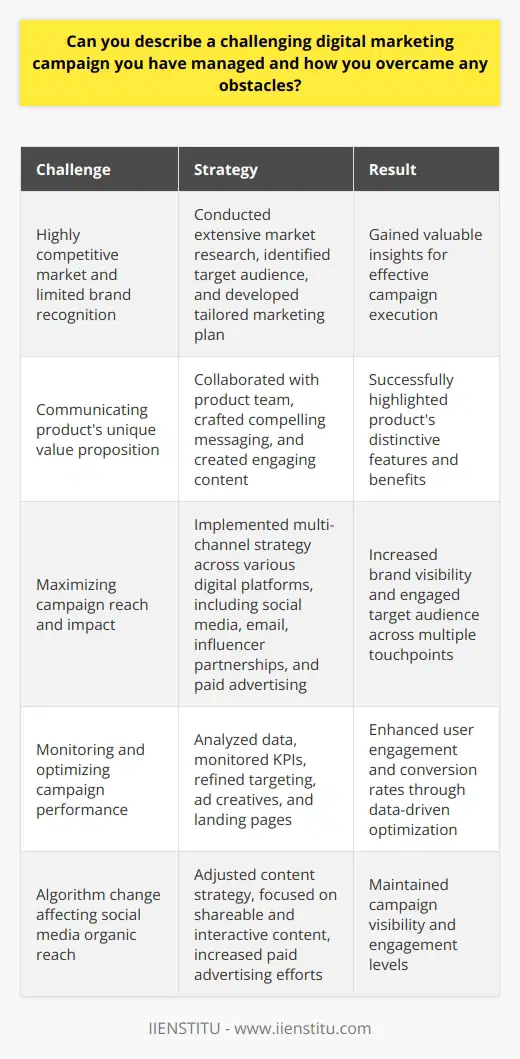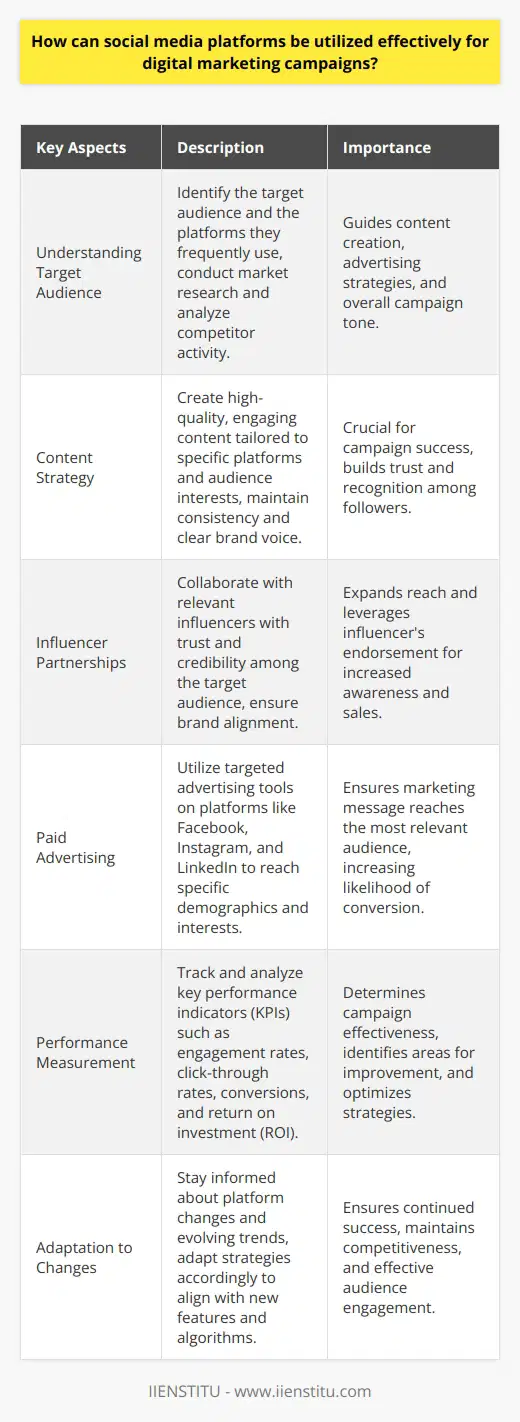
In today's fast-paced digital world, businesses are constantly striving to stay relevant and competitive. To achieve this, companies need to effectively align their content with their digital marketing strategies.
Related Course: Digital Marketing Course
This ensures that the content they produce is reaching the right audience, engaging them, and ultimately driving conversions. In this article, we will explore the importance of aligning content with digital marketing and discuss strategies to achieve this alignment successfully.
Why is this interview question asked: How Do You Align Content with Digital Marketing?
This interview question is commonly asked to candidates applying for marketing and content-related roles. By asking this question, interviewers want to assess the candidate's understanding of the relationship between content and digital marketing. It helps the interviewer evaluate the candidate's knowledge of how to create content that effectively supports digital marketing efforts, and whether they can think strategically about aligning content with broader marketing objectives.
The purpose of the question
The purpose of this question is to gauge the candidate's ability to strategize and execute integrated marketing campaigns. It assesses their understanding of how different types of content can be leveraged to achieve marketing goals across various digital channels. The interviewer wants to see if the candidate can think critically about aligning content with digital marketing while considering the target audience, brand messaging, and overall marketing objectives.
At what interview level is it asked?
This question can be asked at various interview levels, ranging from entry-level positions to senior roles. It is particularly relevant for candidates applying for content marketing specialist, digital marketing manager, or marketing strategist positions. The complexity of the answer may vary depending on the seniority of the role, but the underlying principles of content alignment with digital marketing remain consistent across all levels.
What kind of answer is expected from the candidate?
The interviewer expects the candidate to provide a comprehensive and strategic response that showcases their knowledge of content marketing and digital marketing integration. The candidate should demonstrate an understanding of the target audience, the role of different content formats, and how to measure the effectiveness of content in meeting marketing objectives. Additionally, the candidate should be able to provide specific examples of successful content alignment with digital marketing from their previous work experience or industry knowledge.
Possible answers to consider
Understanding the Target Audience: Aligning content with digital marketing starts with a deep understanding of the target audience. By conducting thorough market research, including analyzing demographics, psychographics, and online behaviors, businesses can create content that resonates with their intended audience. This ensures that the right messages reach the right people at the right time, increasing the chances of engagement and conversion.
Developing Buyer Personas: Buyer personas play a crucial role in aligning content with digital marketing. By creating detailed profiles of their ideal customers, businesses can personalize their content to address their specific pain points, motivations, and preferences. This allows marketers to craft targeted content that speaks directly to the needs of their audience, increasing relevance and engagement.
Utilizing SEO: Search engine optimization (SEO) is a fundamental aspect of aligning content with digital marketing. By conducting keyword research and optimizing content for relevant search terms, businesses can increase their online visibility and drive organic traffic. Incorporating these keywords strategically into the content helps ensure that it appears in search engine results when users are looking for related information or products.
Creating Engaging Content: Engaging content is key to capturing and retaining the attention of the target audience. Through compelling storytelling, captivating visuals, and interactive elements, businesses can create content that grabs the audience's interest and encourages them to take desired actions. This could include subscribing to a newsletter, making a purchase, or sharing the content with their own networks.
Integrating Social Media: Social media platforms are powerful channels for distributing and promoting content. By integrating social media into the overall digital marketing strategy, businesses can amplify the reach of their content and foster meaningful engagement with their audience. Social media can be used to share blog posts, videos, infographics, and other content formats, driving traffic back to the company's website and generating brand visibility.
Measuring and Analyzing Performance: Effective alignment of content with digital marketing requires continuous monitoring and analysis of performance metrics. By tracking key performance indicators (KPIs) such as website traffic, click-through rates, conversions, and social media engagement, businesses can gain valuable insights into the effectiveness of their content. This data informs future content strategies, allowing marketers to optimize their efforts for maximum impact.
What to consider when answering
When answering this question, it is important to showcase a holistic understanding of content marketing and digital marketing integration. Consider the following points:
Demonstrating a Strategic Mindset: Highlight your ability to think strategically and align content with broader marketing objectives. Discuss how you develop content strategies that align with the company's overall digital marketing goals.
Emphasizing Audience-Centric Approach: Showcase your understanding of the importance of the target audience in content alignment. Explain how you conduct audience research and develop buyer personas to create content that resonates with the intended audience.
Discussing Content Formats: Mention various content formats and how they can be leveraged to meet different marketing objectives. Provide examples of how you have utilized blog posts, videos, infographics, and other formats to align content with digital marketing.
Measuring Success: Highlight your experience in measuring and analyzing content performance. Discuss the tools and metrics you use to track content effectiveness and how you iterate on your content strategies based on data insights.
Providing Examples: Whenever possible, provide specific examples from your previous work experience or industry knowledge to illustrate your ability to align content with digital marketing. Discuss successful campaigns where content played a pivotal role in achieving marketing objectives.
In conclusion, aligning content with digital marketing is crucial for businesses aiming to succeed in the digital landscape.
By understanding the target audience, developing buyer personas, utilizing SEO, creating engaging content, integrating social media, and measuring performance, businesses can create a cohesive and effective content marketing strategy that drives results.
When answering this interview question, remember to showcase your strategic thinking, audience-centric approach, and ability to measure and optimize content for maximum impact.
Strategies for Content Alignment in Digital Marketing
Key Components of a Successful Content and Digital Marketing Alignment
Challenges and Solutions in Aligning Content with Digital Marketing
Similar interview questions:
What strategies can be employed to synchronize content with digital marketing efforts?
In what ways can you ensure your content aligns seamlessly with your digital marketing campaigns?
How can businesses effectively integrate their content with their digital marketing strategies?
What techniques do you use to successfully align your content with your digital marketing initiatives?
What steps should be taken to harmonize content with digital marketing goals?
Describe the process of aligning content with digital marketing strategies for optimal results.
What are some best practices for integrating content cohesively with digital marketing activities?
How can you ensure a consistent message across your content and digital marketing channels?
What approaches can be adopted to align content and digital marketing seamlessly?
Discuss the importance of aligning content effectively with digital marketing efforts for business success.
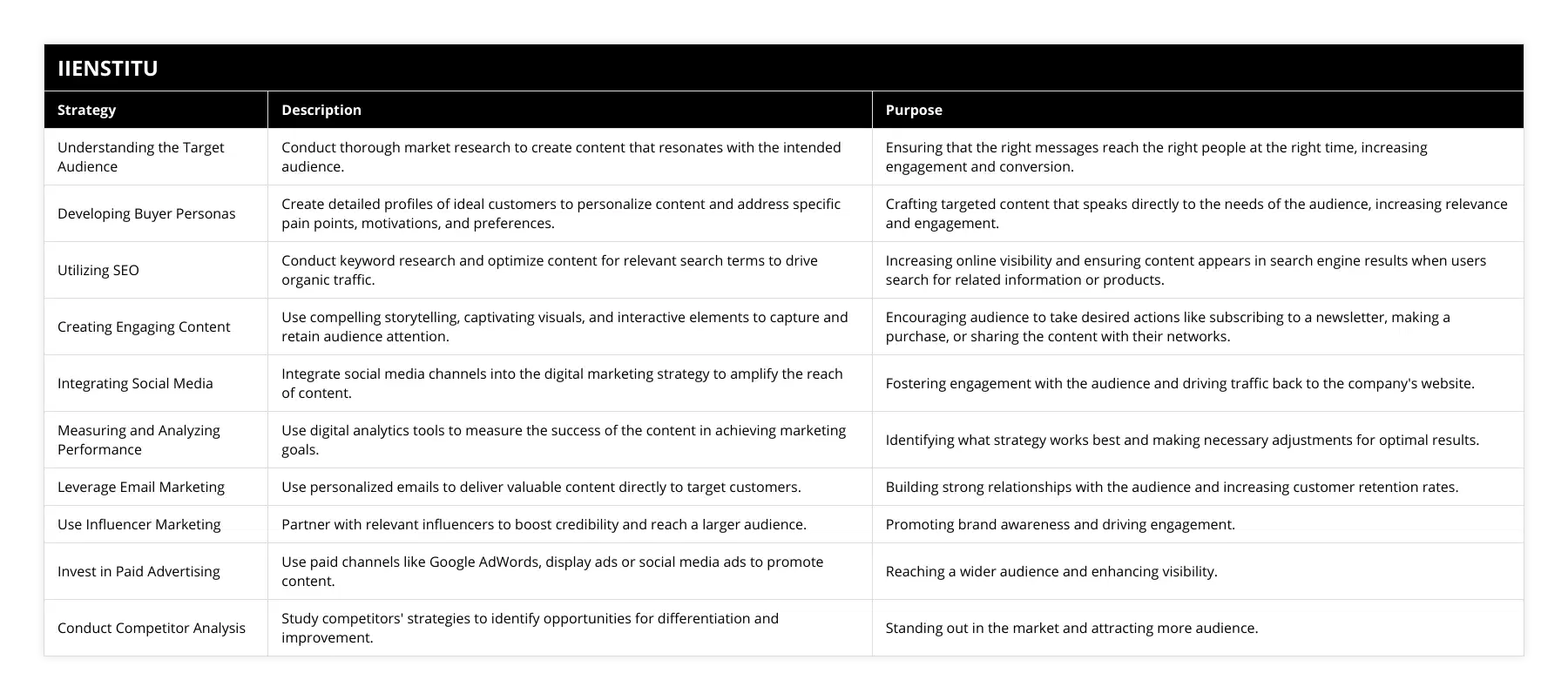
Frequently Asked Questions
What strategies do you employ to ensure that your content aligns with your overall digital marketing objectives?
To ensure that blog content aligns with overall digital marketing objectives, a strategic approach is essential. This involves careful planning, research, and execution to create content that resonates with the target audience and drives meaningful results. By following a well-defined process, marketers can develop blog posts that effectively support their marketing goals and contribute to the success of their digital campaigns.
Understanding Marketing Objectives
The first step in aligning blog content with digital marketing objectives is to clearly define those objectives. Marketers should identify the specific goals they want to achieve through their blog, such as increasing brand awareness, generating leads, or driving sales. By having a clear understanding of these objectives, marketers can create content that is purposeful and targeted.
Conducting Audience Research
To create blog content that resonates with the target audience, marketers must conduct thorough audience research. This involves gathering data on demographics, interests, pain points, and online behaviors. By gaining insights into the audience's needs and preferences, marketers can develop content ideas that address their concerns and provide value.
Keyword Research and Optimization
Keyword research is a crucial component of aligning blog content with digital marketing objectives. By identifying the keywords and phrases that the target audience is searching for, marketers can optimize their blog posts for search engines. This increases the visibility of the content and attracts relevant traffic to the website.
Creating a Content Calendar
To ensure a consistent and strategic approach to blog content creation, marketers should develop a content calendar. This tool helps to plan and organize blog topics, assign responsibilities, and track deadlines. By having a clear roadmap, marketers can ensure that their blog content remains aligned with their marketing objectives and is published on a regular basis.
Measuring and Analyzing Performance
To determine the effectiveness of blog content in achieving digital marketing objectives, it is essential to measure and analyze performance metrics. This includes tracking website traffic, engagement rates, conversion rates, and other relevant key performance indicators (KPIs). By regularly monitoring and analyzing these metrics, marketers can identify areas for improvement and make data-driven decisions to optimize their content strategy.
Continuously Refining and Adapting
Aligning blog content with digital marketing objectives is an ongoing process that requires continuous refinement and adaptation. As market trends, audience preferences, and business goals evolve, marketers must be willing to adjust their content strategy accordingly. By staying agile and responsive to change, marketers can ensure that their blog remains a valuable asset in achieving their digital marketing objectives.

How do you measure the effectiveness of your content in supporting your digital marketing campaigns?
Measuring the effectiveness of your content in supporting digital marketing campaigns is crucial for optimizing your strategy. To gauge the impact of your blog posts, you should track key performance indicators (KPIs) relevant to your goals. These KPIs can include website traffic, engagement metrics, lead generation, and conversion rates.
Website Traffic
Analyze the number of visitors your blog posts attract using tools like Google Analytics. Monitor the sources of traffic, such as organic search, social media, or referral links. An increase in traffic indicates that your content is attracting attention and driving people to your website.
Engagement Metrics
Engagement metrics provide insights into how your audience interacts with your content. Track the average time spent on each blog post, the bounce rate, and the number of pages visited per session. High engagement suggests that your content is resonating with your target audience.
Social Media Shares and Comments
Monitor the number of shares, likes, and comments your blog posts receive on social media platforms. Social engagement indicates that your content is valuable and shareable, expanding its reach beyond your immediate network.
Lead Generation
Assess how effectively your blog posts generate leads for your business. Include clear calls-to-action (CTAs) within your content, directing readers to landing pages, opt-in forms, or contact forms. Track the number of leads generated from each blog post to identify top-performing content.
Conversion Rates
Ultimately, the success of your content depends on its ability to drive conversions. Monitor the conversion rates of visitors who interact with your blog posts. Analyze how many readers take desired actions, such as making a purchase, signing up for a newsletter, or requesting a demo.
A/B Testing
Conduct A/B tests on your blog posts to optimize their effectiveness. Test different headlines, visuals, CTAs, or content formats to identify the elements that resonate best with your audience.
ROI Analysis
Calculate the return on investment (ROI) of your content marketing efforts. Compare the costs of creating and promoting your blog posts against the revenue generated from resulting conversions.
By regularly monitoring these KPIs and making data-driven decisions, you can continually improve the effectiveness of your blog content in supporting your digital marketing campaigns.

In what ways do you adapt your content to cater to different target audiences across various digital marketing channels?
Adapting content to cater to different target audiences across various digital marketing channels is crucial for effective communication. By understanding the unique characteristics, preferences, and behaviors of each audience segment, marketers can tailor their messaging and format accordingly. This customization enhances the relevance and impact of the content, leading to higher engagement and conversions.
Identifying Target Audiences
The first step in adapting content is to identify and define the target audiences for each digital channel. Marketers should conduct thorough research to gain insights into the demographics, psychographics, and online behaviors of their desired audiences. This information helps create detailed buyer personas, which serve as a guide for content creation and distribution.
Researching Audience Preferences
To effectively adapt content, marketers must research the preferences and expectations of each target audience. This includes analyzing their content consumption habits, preferred formats, and the devices they commonly use. By understanding these preferences, marketers can optimize their content to meet the specific needs and desires of each audience segment.
Tailoring Content Format and Style
Different digital channels require distinct content formats and styles to engage their respective audiences effectively. For example, Instagram users tend to favor visually appealing images and short videos, while LinkedIn users prefer professional and informative content. Marketers should adapt their content format and style to match the norms and best practices of each platform.
Adjusting Tone and Language
The tone and language used in content should align with the expectations and preferences of the target audience. A younger audience may respond well to a more casual and conversational tone, while an older audience may prefer a more formal and informative approach. Marketers should adjust their writing style to resonate with the specific audience they are targeting on each channel.
Optimizing for Different Devices
With the proliferation of mobile devices, it is essential to optimize content for different screen sizes and resolutions. Marketers should ensure that their content is responsive and easily consumable across desktop computers, tablets, and smartphones. This includes using mobile-friendly formats, such as vertical videos and responsive design, to provide a seamless user experience.
Testing and Iterating
Adapting content for different target audiences is an ongoing process that requires continuous testing and iteration. Marketers should monitor the performance of their content across various channels and use data-driven insights to refine their strategies. By analyzing metrics such as engagement rates, click-through rates, and conversion rates, marketers can identify what works best for each audience and make data-informed decisions to optimize their content.
Leveraging Personalization
Personalization is a powerful tool for adapting content to individual audience members. By leveraging data and technology, marketers can deliver highly targeted and relevant content to specific individuals based on their interests, behaviors, and preferences. Personalization techniques, such as dynamic content and targeted email campaigns, can significantly enhance the effectiveness of content adaptation efforts.
In conclusion, adapting content to cater to different target audiences across various digital marketing channels is essential for maximizing the impact and effectiveness of marketing efforts. By identifying target audiences, researching their preferences, tailoring content format and style, optimizing for different devices, testing and iterating, and leveraging personalization, marketers can create content that resonates with each audience segment and drives meaningful results.

What are some common challenges faced in digital marketing campaigns, and how can they be overcome?
Digital marketing campaigns face various challenges that can hinder their success. One common challenge is targeting the right audience. Without a clear understanding of the target audience, campaigns may fail to resonate with potential customers. To overcome this, marketers should conduct thorough research and create detailed buyer personas. This helps in crafting messages and selecting channels that align with the audience's preferences and behaviors.
Measuring ROI
Another challenge is measuring the return on investment (ROI) of digital marketing efforts. With numerous touchpoints and data sources, attributing conversions to specific campaigns can be difficult. To address this, marketers should establish clear goals and key performance indicators (KPIs) from the outset. Implementing robust tracking and analytics tools can help monitor performance and make data-driven decisions.
Adapting to Algorithm Changes
Digital platforms, such as search engines and social media networks, frequently update their algorithms. These changes can impact the visibility and effectiveness of digital marketing campaigns. To stay ahead, marketers must keep abreast of algorithm updates and adapt their strategies accordingly. This may involve optimizing content for search engines, leveraging paid advertising, or exploring alternative channels to maintain reach and engagement.
Managing Budget Constraints
Budget constraints can limit the scope and impact of digital marketing campaigns. Marketers must allocate resources wisely to maximize returns. This involves prioritizing channels and tactics that have proven to be effective. Continuously monitoring and optimizing campaigns can help identify areas for improvement and ensure budget is spent efficiently.
Ensuring Content Quality and Relevance
Creating high-quality, relevant content is crucial for engaging audiences and driving conversions. However, producing consistent, valuable content can be challenging. Marketers should develop a content strategy that aligns with their target audience's needs and interests. Collaborating with subject matter experts, leveraging user-generated content, and repurposing existing assets can help maintain a steady flow of fresh, engaging content.
Staying Up-to-Date with Technology
The digital landscape is constantly evolving, with new technologies and platforms emerging regularly. Marketers must stay informed about the latest trends and tools to remain competitive. This may involve investing in training and development, attending industry events, and experimenting with new tactics and technologies.
Overcoming Ad Fatigue and Banner Blindness
Ad fatigue and banner blindness can reduce the effectiveness of digital advertising campaigns. To combat this, marketers should focus on creating compelling, visually appealing ads that offer value to the viewer. Employing retargeting techniques, personalization, and interactive elements can help capture attention and drive engagement.
By addressing these common challenges, digital marketers can improve the effectiveness of their campaigns and achieve better results. A combination of strategic planning, data-driven decision-making, and continuous optimization is key to overcoming obstacles and maximizing the impact of digital marketing efforts.
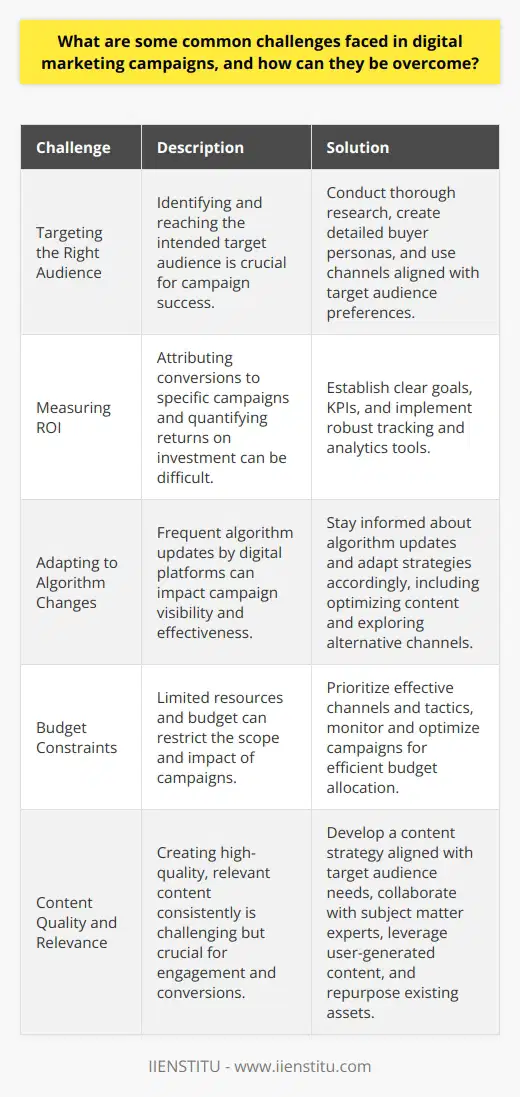
How do you measure the success of a digital marketing strategy, and what key performance indicators (KPIs) should be tracked?
Measuring the success of a digital marketing strategy involves tracking various key performance indicators (KPIs). These KPIs help businesses determine whether their marketing efforts are yielding the desired results. The specific KPIs to track depend on the goals of the digital marketing campaign.
Website Traffic
Website traffic is a crucial KPI to monitor. It indicates how many people are visiting your website. Tools like Google Analytics can help track website traffic, including the number of unique visitors, pageviews, and bounce rate. An increase in website traffic suggests that your digital marketing strategies are effectively driving people to your site.
Conversion Rate
Conversion rate measures the percentage of website visitors who take a desired action. This action could be making a purchase, filling out a form, or subscribing to a newsletter. A high conversion rate indicates that your marketing strategies are not only attracting visitors but also encouraging them to engage with your business.
Cost per Acquisition (CPA)
CPA measures the cost of acquiring a new customer through your digital marketing efforts. To calculate CPA, divide the total marketing spend by the number of new customers acquired. A lower CPA indicates a more cost-effective marketing strategy.
Return on Investment (ROI)
ROI measures the profitability of your digital marketing efforts. To calculate ROI, divide the net profit by the total marketing spend and multiply by 100. A positive ROI indicates that your marketing strategies are generating more revenue than they cost.
Engagement Metrics
Engagement metrics measure how actively your audience interacts with your digital marketing content. These metrics include likes, shares, comments, and click-through rates. High engagement rates suggest that your content resonates with your target audience.
Social Media Followers
The number of social media followers is an important KPI for businesses using social media marketing. An increase in followers indicates that your social media content is attracting and retaining an audience.
Email Marketing Metrics
For email marketing campaigns, track metrics like open rates, click-through rates, and conversion rates. These metrics provide insights into the effectiveness of your email marketing strategies.
Customer Lifetime Value (CLV)
CLV measures the total revenue a customer generates for your business over their lifetime. A higher CLV indicates that your marketing strategies are attracting valuable, long-term customers.
To measure the success of your digital marketing strategy, regularly track and analyze these KPIs. Use the insights gained to optimize your marketing efforts and allocate resources effectively. Remember, the specific KPIs to track will depend on your unique business goals and marketing objectives.

What strategies do you recommend for improving search engine optimization (SEO) and increasing organic traffic to a website?
To improve search engine optimization (SEO) and increase organic traffic to a website, several strategies can be implemented. First, conduct thorough keyword research to identify relevant and high-traffic keywords for your blog post. Incorporate these keywords naturally throughout the content, including the title, headings, and meta description. Ensure that the content is well-structured, informative, and provides value to the reader.
Optimize On-Page Elements
Optimize on-page elements such as the title tag, meta description, and header tags (H1, H2, etc.). Use descriptive and compelling titles that include the main keyword. Write meta descriptions that accurately summarize the content and entice users to click. Use header tags to organize the content and signal its hierarchy to search engines.
Create High-Quality Content
Focus on creating high-quality, original, and engaging content that addresses the needs and interests of your target audience. In-depth, well-researched blog posts that provide valuable information tend to rank higher in search results. Use relevant images, videos, and other media to enhance the user experience and keep visitors engaged.
Improve Website Speed and Mobile-Friendliness
Optimize your website's loading speed by compressing images, minimizing code, and leveraging caching techniques. Fast-loading websites rank higher and provide a better user experience. Ensure that your website is mobile-friendly and responsive across different devices. Mobile-friendliness is a crucial ranking factor for search engines.
Build Quality Backlinks
Engage in link building strategies to acquire high-quality backlinks from reputable and relevant websites. Reach out to industry influencers, participate in guest blogging, and create shareable content that naturally attracts links. Backlinks act as votes of confidence and help improve your website's authority and search engine rankings.
Promote Content on Social Media
Leverage social media platforms to promote your blog post and drive traffic to your website. Share the post on relevant social networks and engage with your audience. Encourage social sharing by including share buttons on your blog post. Social signals can indirectly impact SEO by increasing visibility and attracting more backlinks.
Monitor and Analyze Performance
Use web analytics tools to monitor your website's performance and track key metrics such as organic traffic, bounce rate, and time on page. Analyze the data to identify areas for improvement and make data-driven decisions. Regularly monitor your search engine rankings for targeted keywords and adjust your strategy accordingly.
Conclusion
Improving SEO and increasing organic traffic to a website requires a comprehensive approach. By implementing these strategies consistently and staying up-to-date with the latest SEO best practices, you can enhance your blog post's visibility, attract more organic traffic, and improve your search engine rankings over time.
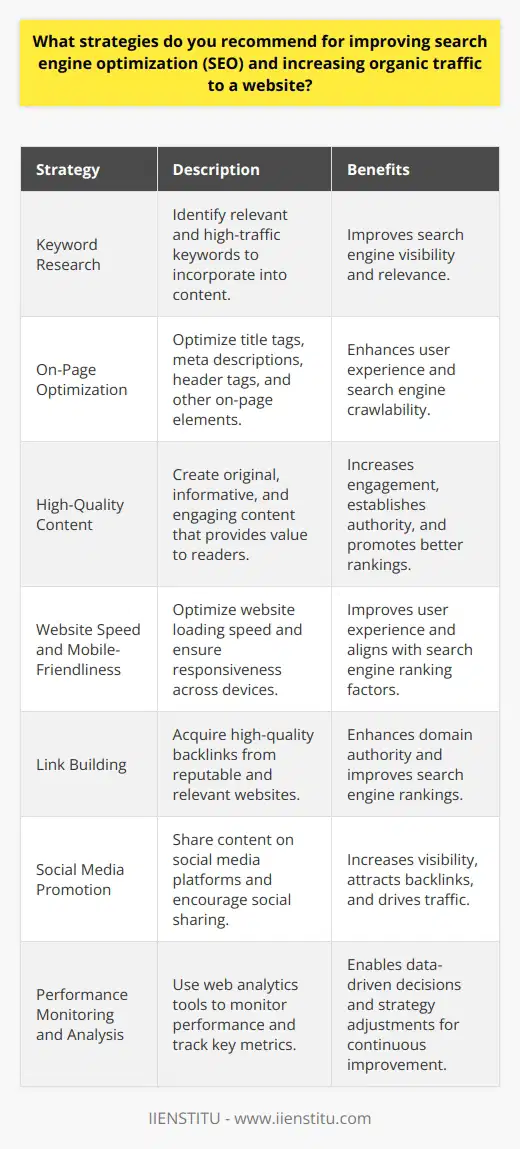
What are the key components of a successful digital marketing strategy?
A successful digital marketing strategy encompasses several key components that work together to achieve business objectives. These components include a well-defined target audience, clear goals and objectives, and a comprehensive approach to reach and engage customers across various digital channels. Let's explore each of these components in more detail.
Defining Your Target Audience
The foundation of any successful digital marketing strategy is a clear understanding of your target audience. This involves conducting thorough market research to identify the demographics, interests, and behaviors of your ideal customers. By creating detailed buyer personas, you can tailor your marketing efforts to effectively reach and resonate with your target audience.
Conducting Market Research
To gain insights into your target audience, utilize various market research techniques such as surveys, focus groups, and analytics tools. Analyze customer data, social media interactions, and website behavior to uncover valuable information about your audience's preferences, pain points, and purchasing habits. This research will guide your content creation, messaging, and overall marketing approach.
Setting Clear Goals and Objectives
A successful digital marketing strategy requires well-defined goals and objectives that align with your business's overall mission. These goals should be specific, measurable, achievable, relevant, and time-bound (SMART). Examples of digital marketing goals include increasing website traffic, generating leads, improving conversion rates, and enhancing brand awareness.
Aligning with Business Objectives
Ensure that your digital marketing goals are in line with your company's broader objectives. Consider how your marketing efforts can contribute to revenue growth, customer acquisition, and brand loyalty. Regularly assess and adjust your goals based on performance data and changing market conditions to maintain alignment and optimize your strategy.
Implementing a Multi-Channel Approach
An effective digital marketing strategy leverages multiple channels to reach and engage your target audience. This multi-channel approach includes tactics such as search engine optimization (SEO), pay-per-click (PPC) advertising, social media marketing, email marketing, and content marketing. By utilizing a combination of these channels, you can maximize your reach and impact.
Optimizing for Search Engines
SEO is crucial for improving your website's visibility in search engine results pages (SERPs). Conduct keyword research to identify relevant terms and phrases that your target audience uses when searching for products or services like yours. Optimize your website's content, structure, and meta tags to improve its ranking and attract organic traffic.
Leveraging Social Media
Social media platforms provide powerful opportunities to connect with your target audience and build brand awareness. Develop a social media strategy that aligns with your overall marketing goals and target audience preferences. Create engaging content, participate in relevant conversations, and utilize paid social media advertising to expand your reach and drive targeted traffic to your website.
Engaging Through Email Marketing
Email marketing allows you to directly communicate with your subscribers and nurture leads. Build an email list by offering valuable content, exclusive offers, or promotions in exchange for contact information. Segment your email list based on subscriber preferences and behaviors to deliver personalized and relevant content. Use email automation to streamline your efforts and optimize your campaigns.
Creating Valuable Content
Content marketing is a fundamental aspect of digital marketing. Develop a content strategy that addresses your target audience's needs, interests, and pain points. Create high-quality, informative, and engaging content in various formats, such as blog posts, videos, infographics, and eBooks. Consistently publish and promote your content to attract and retain a loyal audience.
Measuring and Analyzing Performance
To ensure the success of your digital marketing strategy, regularly measure and analyze your performance. Use analytics tools to track key metrics such as website traffic, conversion rates, engagement, and ROI. Monitor your campaigns' performance across different channels and make data-driven decisions to optimize your strategy.
Setting Key Performance Indicators (KPIs)
Establish clear KPIs that align with your digital marketing goals. These KPIs should be specific, measurable, and relevant to your business objectives. Examples of KPIs include website traffic, lead generation, conversion rates, and social media engagement. Regularly review your KPIs to assess the effectiveness of your marketing efforts and make necessary adjustments.

How can businesses effectively measure the ROI of their digital marketing campaigns?
Measuring the return on investment (ROI) of digital marketing campaigns is crucial for businesses to optimize their marketing efforts. To effectively measure ROI, businesses should start by setting clear, measurable goals for each campaign. These goals should align with the overall business objectives and be specific, such as increasing website traffic or generating leads.
Next, businesses need to track and analyze relevant metrics that correspond to their campaign goals. For example, if the goal is to increase website traffic, businesses should monitor website analytics, such as the number of unique visitors, bounce rate, and time spent on the site. If the goal is to generate leads, businesses should track the number of form submissions, email signups, or phone calls received.
Attributing Conversions to Marketing Channels
To accurately measure ROI, businesses must attribute conversions to specific marketing channels. This can be done using various attribution models, such as first-touch, last-touch, or multi-touch attribution. First-touch attribution assigns credit to the first marketing channel a customer interacted with, while last-touch attribution assigns credit to the last channel before the conversion. Multi-touch attribution distributes credit among all the marketing channels a customer interacted with before converting.
Using UTM Parameters
Businesses can use UTM (Urchin Tracking Module) parameters to track the performance of specific campaigns, ads, or links. UTM parameters are added to the end of a URL and provide information about the source, medium, and campaign name. By using UTM parameters consistently, businesses can better attribute conversions to specific marketing efforts and calculate ROI more accurately.
Calculating ROI
To calculate ROI, businesses should use the following formula: (Revenue generated - Cost of campaign) / Cost of campaign. Revenue generated can be determined by multiplying the number of conversions by the average value of a conversion. The cost of the campaign includes all expenses related to the specific marketing effort, such as ad spend, content creation, and agency fees.
A/B Testing
A/B testing involves comparing two versions of a marketing asset, such as an ad or landing page, to determine which performs better. By conducting A/B tests, businesses can optimize their campaigns and improve ROI over time. It is essential to test only one element at a time to accurately identify which changes lead to better performance.
Regularly Review and Adjust
Measuring ROI should be an ongoing process. Businesses should regularly review their marketing performance and make data-driven decisions to optimize their campaigns. This may involve adjusting targeting, messaging, or budget allocation based on the insights gained from ROI analysis.
Collaborate with Stakeholders
To ensure the success of digital marketing campaigns and accurate ROI measurement, businesses should foster collaboration among various stakeholders, including marketing, sales, and finance teams. By working together and sharing insights, teams can develop a comprehensive understanding of the customer journey and make informed decisions to improve overall marketing performance.
In conclusion, measuring the ROI of digital marketing campaigns requires setting clear goals, tracking relevant metrics, attributing conversions accurately, and calculating ROI using a straightforward formula. By regularly reviewing performance, conducting A/B tests, and collaborating with stakeholders, businesses can optimize their digital marketing efforts and maximize their return on investment.

What are some best practices for optimizing a website for search engines in the context of digital marketing?
Optimizing a website for search engines is a crucial aspect of digital marketing. Several best practices can significantly improve a website's visibility and rankings in search engine results pages (SERPs). One fundamental strategy is to conduct thorough keyword research to identify relevant and high-traffic keywords that align with the website's content and target audience. By strategically incorporating these keywords into the website's content, meta tags, and URLs, search engines can better understand and index the site's relevance to specific search queries.
On-Page Optimization
On-page optimization plays a vital role in improving a website's search engine rankings. This involves optimizing individual web pages to make them more search engine-friendly and relevant to target keywords. Key elements of on-page optimization include crafting compelling and keyword-rich title tags, meta descriptions, and header tags (H1, H2, etc.). Additionally, ensuring that the website's content is high-quality, informative, and engaging can help attract and retain visitors while signaling to search engines that the site offers value to users.
Content Quality and Relevance
Creating high-quality, original, and relevant content is essential for SEO success. Search engines favor websites that provide valuable and informative content that addresses users' needs and search intent. Regularly updating the website with fresh, keyword-optimized content can help maintain and improve search engine rankings over time. This can include blog posts, articles, product descriptions, and other forms of content that align with the website's niche and target audience.
Technical SEO
Technical SEO focuses on optimizing the website's underlying structure and performance to enhance its visibility and crawlability by search engines. This involves ensuring that the website has a clean and organized site architecture, with a logical hierarchy of pages and intuitive navigation. Implementing responsive design to provide a seamless user experience across different devices and screen sizes is also crucial. Moreover, optimizing the website's loading speed, fixing broken links, and using structured data markup can further improve its technical SEO performance.
Link Building
Link building is the process of acquiring high-quality, relevant backlinks from other reputable websites. Backlinks act as "votes of confidence" in the eyes of search engines, signaling that other websites consider the content valuable and trustworthy. Engaging in ethical link building practices, such as creating valuable content that naturally attracts links, guest blogging on relevant websites, and leveraging social media to promote content, can help build a strong and diverse backlink profile.
Mobile-Friendliness and Page Speed
With the increasing prevalence of mobile devices, having a mobile-friendly website is no longer optional. Search engines, particularly Google, prioritize mobile-friendly websites in their search results. Implementing responsive design, optimizing images and other media for faster loading times, and ensuring that the website is easily navigable on smaller screens can significantly improve its mobile-friendliness. Additionally, optimizing page speed by minimizing HTTP requests, enabling compression, and leveraging browser caching can enhance the user experience and improve search engine rankings.
Monitoring and Analytics
Regularly monitoring the website's performance and analyzing key metrics is essential for measuring the success of SEO efforts. Tools like Google Analytics and Google Search Console provide valuable insights into website traffic, user behavior, and search engine rankings. By tracking and analyzing this data, digital marketers can identify areas for improvement, fine-tune their SEO strategies, and make data-driven decisions to optimize the website's performance continuously.
In conclusion, optimizing a website for search engines requires a comprehensive approach that encompasses various best practices. By focusing on keyword research, on-page optimization, high-quality content, technical SEO, link building, mobile-friendliness, and performance monitoring, digital marketers can significantly improve a website's visibility, rankings, and organic traffic in search engine results pages.
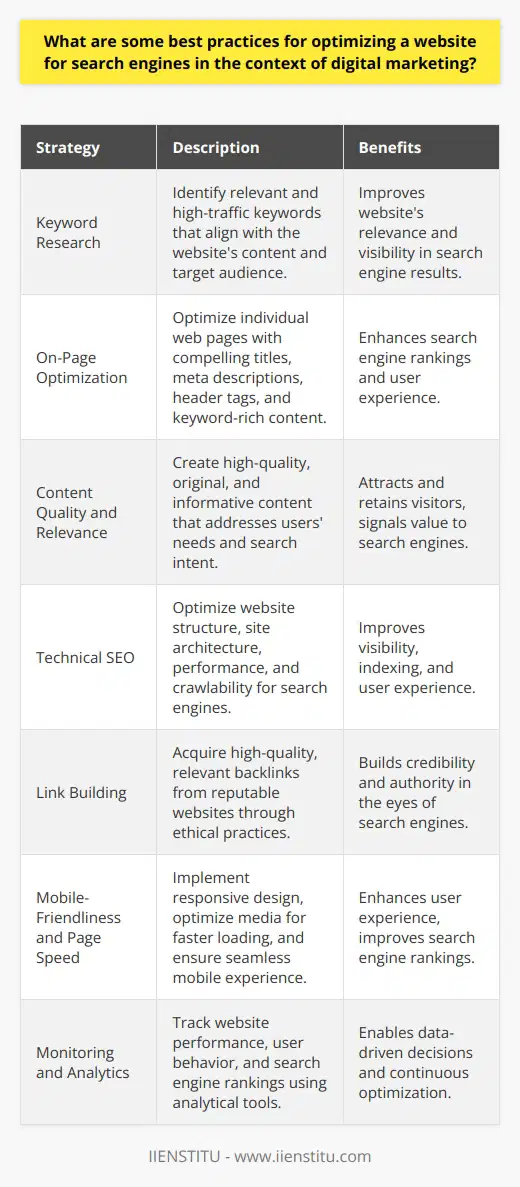
What are the most effective digital marketing strategies for targeting a specific audience?
Digital marketing strategies have evolved significantly in recent years, offering businesses a wide range of tools to reach their target audience effectively. To maximize the impact of digital marketing efforts, it is essential to identify and implement the most effective strategies for targeting a specific audience. This article explores some of the most successful digital marketing techniques that businesses can employ to engage their desired demographic.
Defining Your Target Audience
The first step in developing an effective digital marketing strategy is to clearly define your target audience. This involves conducting thorough market research to identify the demographics, psychographics, and behaviors of your ideal customer. By understanding their needs, preferences, and online habits, you can tailor your marketing messages and channels to resonate with them more effectively.
Creating Buyer Personas
One useful tool in defining your target audience is the creation of buyer personas. These are fictional representations of your ideal customers based on real data and insights. They help you visualize your target audience as real people, making it easier to create content and campaigns that speak directly to their needs and interests.
Choosing the Right Digital Marketing Channels
Once you have a clear understanding of your target audience, the next step is to select the most appropriate digital marketing channels to reach them. Different channels have varying strengths and weaknesses, and the effectiveness of each will depend on your specific audience and goals.
Social Media Marketing
Social media platforms like Facebook, Instagram, and LinkedIn offer powerful tools for targeting specific audiences. By leveraging the demographic and interest-based targeting options available on these platforms, you can ensure that your content reaches the right people at the right time.
Search Engine Optimization (SEO)
SEO is a crucial strategy for reaching audiences who are actively searching for products or services like yours. By optimizing your website and content for relevant keywords and phrases, you can improve your visibility in search engine results pages (SERPs) and attract highly qualified traffic to your site.
Pay-Per-Click (PPC) Advertising
PPC advertising, such as Google Ads and Facebook Ads, allows you to place targeted ads in front of your desired audience. These platforms offer extensive targeting options, enabling you to reach people based on factors like demographics, interests, behaviors, and location.
Content Marketing
Creating valuable, informative, and engaging content is a powerful way to attract and retain your target audience. By understanding their needs and pain points, you can develop content that addresses their concerns and establishes your brand as a trusted authority in your industry.
Measuring and Optimizing Your Results
To ensure the success of your digital marketing efforts, it is essential to continuously measure and optimize your results. By tracking key performance indicators (KPIs) such as website traffic, engagement rates, and conversions, you can gain valuable insights into what is working and what needs improvement.
A/B Testing
A/B testing is a powerful technique for optimizing your digital marketing campaigns. By comparing two versions of a marketing asset, such as an ad or landing page, you can determine which one performs better with your target audience and make data-driven decisions to improve your results.
In conclusion, the most effective digital marketing strategies for targeting a specific audience involve a combination of thorough market research, careful selection of marketing channels, and continuous measurement and optimization. By taking the time to understand your target audience and tailoring your approach accordingly, you can maximize the impact of your digital marketing efforts and achieve your business goals.

What metrics should be used to measure the success of a digital marketing campaign?
Measuring the success of a digital marketing campaign requires a comprehensive approach that takes into account various key performance indicators (KPIs). These metrics should align with the campaign's objectives and provide valuable insights into its effectiveness. The following are essential metrics to consider when evaluating the success of a digital marketing campaign:
1. Website Traffic
Website traffic is a fundamental metric that indicates the number of visitors attracted to the site through the campaign. Analyzing the sources of traffic, such as organic search, social media, or paid advertising, helps determine which channels are most effective. Additionally, monitoring the behavior of visitors, including bounce rates, time spent on the site, and pages viewed per session, provides insights into the quality of the traffic and the engagement level of the audience.
2. Conversion Rates
Conversion rates measure the percentage of visitors who take a desired action, such as making a purchase, filling out a form, or subscribing to a newsletter. This metric directly reflects the effectiveness of the campaign in achieving its goals. Tracking conversion rates at different stages of the customer journey, from initial interest to final purchase, helps identify areas for improvement and optimize the campaign accordingly.
2.1. Micro-Conversions
Micro-conversions are smaller actions that indicate engagement and progress towards the ultimate goal. These may include email signups, social media follows, or content downloads. Monitoring micro-conversions provides a more comprehensive view of the campaign's impact and helps identify potential leads for nurturing.
3. Return on Investment (ROI)
ROI measures the financial return generated by the campaign relative to its cost. It helps determine whether the investment in the campaign is justified and if it contributes positively to the overall business objectives. To calculate ROI, the revenue generated from the campaign is divided by the total cost of the campaign, expressed as a percentage.
3.1. Customer Lifetime Value (CLV)
CLV represents the total amount of money a customer is expected to spend on the business over their lifetime. Incorporating CLV into the ROI calculation provides a long-term perspective on the campaign's success and helps justify the acquisition costs.
4. Engagement Metrics
Engagement metrics measure how actively the audience interacts with the campaign's content. These include likes, comments, shares, and click-through rates on social media posts, email open rates, and video views. High engagement levels indicate that the content resonates with the target audience and encourages further interaction with the brand.
4.1. Social Media Metrics
Social media metrics, such as follower growth, reach, and sentiment analysis, provide insights into the campaign's impact on brand awareness and reputation. Monitoring social media conversations and mentions helps gauge the audience's perception of the brand and identify opportunities for improvement.
5. Cost per Acquisition (CPA)
CPA measures the cost of acquiring a new customer through the campaign. It is calculated by dividing the total campaign cost by the number of new customers acquired. Monitoring CPA helps optimize the campaign's budget allocation and ensures that the acquisition costs align with the business's financial goals.
In conclusion, measuring the success of a digital marketing campaign requires a holistic approach that considers various metrics. By tracking website traffic, conversion rates, ROI, engagement, and acquisition costs, marketers can gain valuable insights into the campaign's performance and make data-driven decisions to optimize its effectiveness. Regular monitoring and analysis of these metrics enable continuous improvement and ensure that the campaign contributes positively to the overall business objectives.
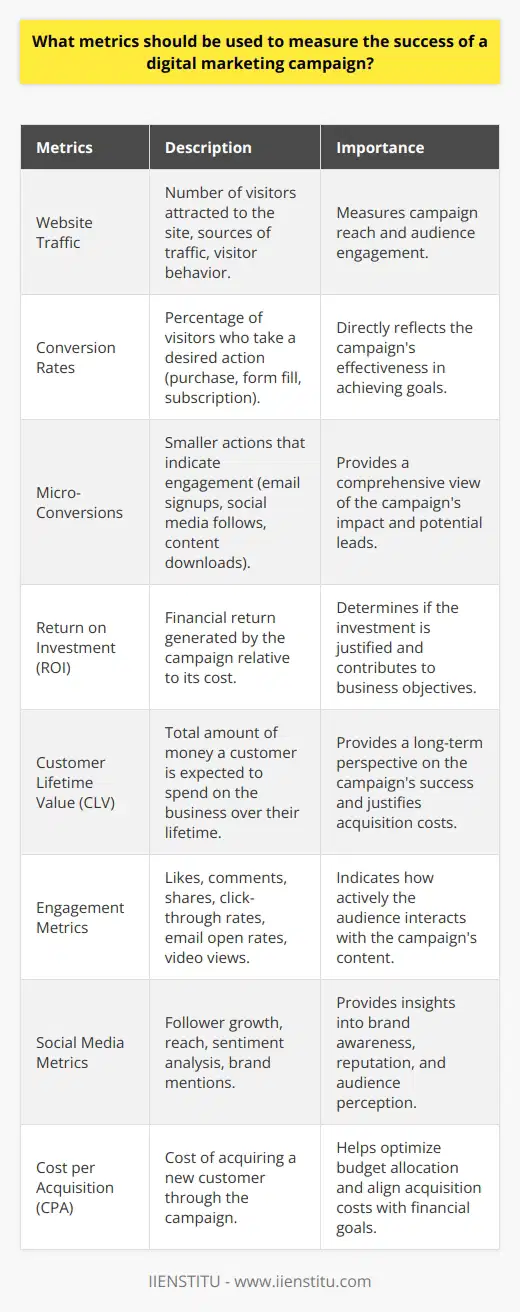
Why do you want to pursue a career in digital marketing?
Pursuing a career in digital marketing offers a multitude of opportunities for personal and professional growth. In today's rapidly evolving technological landscape, digital marketing has become an indispensable tool for businesses to reach and engage with their target audience. The dynamic nature of this field, coupled with its potential for creativity and innovation, makes it an exceptionally appealing career choice.
The Ever-Evolving Digital Landscape
The digital marketing industry is constantly evolving, presenting new challenges and opportunities for marketers to explore. From social media platforms to search engine algorithms, the digital landscape undergoes frequent changes that require marketers to adapt and stay up-to-date with the latest trends and best practices. This fast-paced environment ensures that a career in digital marketing never becomes stagnant, as there is always something new to learn and implement.
Unleashing Creativity and Innovation
Digital marketing provides a platform for individuals to unleash their creativity and develop innovative strategies to capture the attention of their target audience. From crafting compelling content to designing visually appealing campaigns, digital marketers have the opportunity to think outside the box and experiment with various approaches to engage and convert potential customers. The ability to combine analytical skills with creative thinking makes digital marketing a truly rewarding career path.
Measurable Results and Data-Driven Decisions
One of the most appealing aspects of digital marketing is the ability to measure and analyze the effectiveness of campaigns in real-time. Unlike traditional marketing methods, digital marketing provides a wealth of data and insights that enable marketers to make informed, data-driven decisions. By leveraging tools such as Google Analytics, digital marketers can track key performance indicators, optimize campaigns, and demonstrate the return on investment (ROI) of their efforts.
Collaborating with Cross-Functional Teams
Digital marketing often involves collaborating with cross-functional teams, including designers, developers, content creators, and sales representatives. This collaborative environment fosters a sense of teamwork and allows for the exchange of ideas and expertise. By working closely with professionals from various disciplines, digital marketers can develop a holistic understanding of the customer journey and create integrated campaigns that effectively reach and resonate with the target audience.
Endless Growth Opportunities
The digital marketing industry offers endless opportunities for growth and advancement. As businesses increasingly recognize the importance of establishing a strong online presence, the demand for skilled digital marketers continues to rise. This growing demand translates into diverse career paths and the potential for rapid career progression. Whether one aspires to specialize in a specific area of digital marketing, such as search engine optimization (SEO) or social media marketing, or to take on leadership roles, the possibilities are vast.
In conclusion, pursuing a career in digital marketing is an exciting and rewarding choice for individuals who thrive in a dynamic and fast-paced environment. The ever-evolving nature of the industry, coupled with the opportunity to unleash creativity, make data-driven decisions, and collaborate with cross-functional teams, makes digital marketing a fulfilling and challenging career path. With endless growth opportunities and the potential to make a significant impact on businesses' online success, a career in digital marketing offers a promising future for those who are passionate about the digital world.
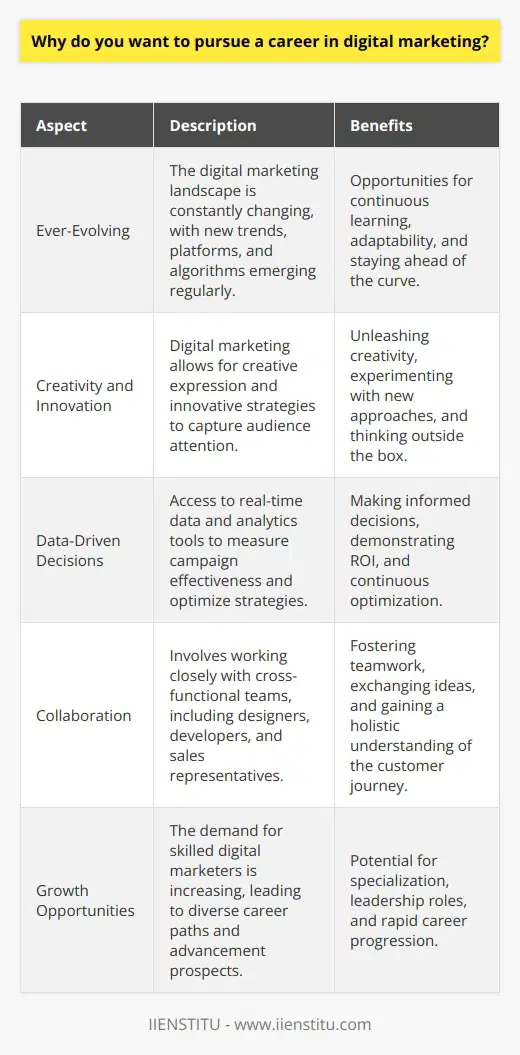
What aspects of digital marketing interest you the most, and why?
Digital marketing encompasses a wide range of strategies and techniques that fascinate me for several reasons. Firstly, the ability to reach a vast audience through various digital channels is incredibly powerful. By leveraging social media platforms, search engine optimization, and targeted advertising, businesses can connect with their ideal customers on a global scale. This reach allows for unprecedented growth opportunities and the ability to build brand awareness in ways that were previously impossible.
The Power of Data Analytics
Another aspect of digital marketing that intrigues me is the role of data analytics. Digital marketers can collect and analyze vast amounts of data on consumer behavior, preferences, and engagement. This data-driven approach enables marketers to make informed decisions and optimize their strategies for maximum impact. By understanding the target audience on a deeper level, marketers can create personalized experiences that resonate with individual customers, leading to higher conversion rates and customer loyalty.
The Importance of Engaging Content
Creating compelling and engaging content is also a crucial aspect of digital marketing that I find fascinating. In the digital age, consumers are bombarded with information from every direction. To stand out from the noise, marketers must craft content that not only informs but also captivates their audience. Whether it's through blog posts, videos, infographics, or interactive experiences, the ability to tell a brand's story and connect with customers on an emotional level is an art form that I greatly admire.
The Ever-Evolving Nature of Digital Marketing
Moreover, the constantly evolving nature of digital marketing keeps me on my toes. As new technologies and platforms emerge, marketers must adapt and innovate to stay ahead of the curve. The rise of artificial intelligence, virtual reality, and voice search are just a few examples of how digital marketing is transforming. The opportunity to continuously learn and experiment with new strategies is both challenging and exciting, making digital marketing a field that never grows stale.
The Measurability of Digital Marketing Efforts
Finally, I am drawn to the measurability of digital marketing efforts. Unlike traditional marketing methods, digital marketing allows for precise tracking and measurement of campaign performance. Through tools like Google Analytics, marketers can monitor website traffic, user behavior, and conversion rates in real-time. This level of transparency and accountability enables marketers to optimize their campaigns, allocate resources effectively, and demonstrate the return on investment to stakeholders.
Conclusion
In conclusion, the world of digital marketing is a fascinating and ever-evolving field that offers endless opportunities for creativity, innovation, and growth. From the ability to reach a global audience to the power of data analytics and the importance of engaging content, digital marketing encompasses a wide range of aspects that captivate my interest. As technology continues to advance and consumer behavior evolves, I am excited to be a part of this dynamic industry and contribute to its future development.
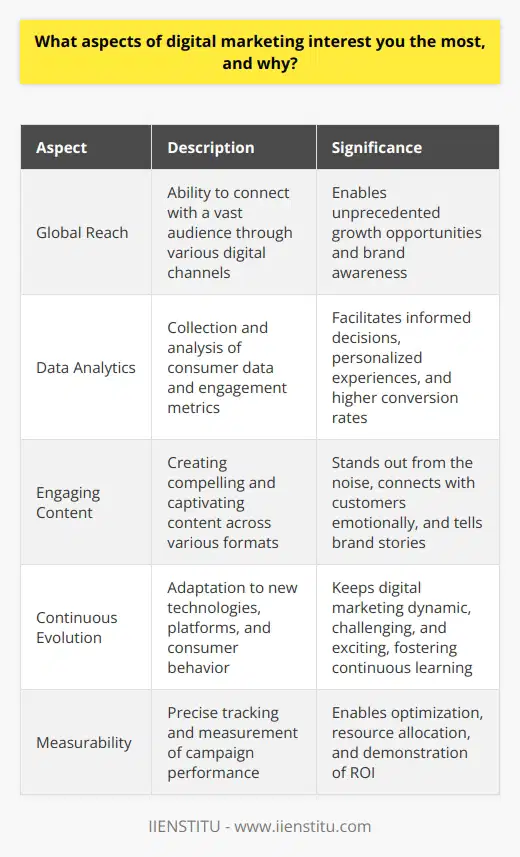
How do you believe your skills and experiences make you a strong candidate for a role in digital marketing?
I believe my skills and experiences make me a strong candidate for a role in digital marketing. My educational background in marketing and my practical experience in social media management have provided me with a solid foundation. I have developed a keen understanding of digital marketing strategies and techniques through my coursework and self-directed learning.
Practical Experience
I have hands-on experience in creating and managing social media campaigns across various platforms. This experience has taught me how to engage with audiences, create compelling content, and analyze performance metrics. I have also collaborated with cross-functional teams to develop and execute digital marketing strategies aligned with business objectives.
Analytical Skills
My strong analytical skills allow me to interpret data and derive actionable insights. I am proficient in using analytics tools to track and measure the success of digital marketing campaigns. This enables me to make data-driven decisions and optimize strategies for better results.
Content Creation
I possess excellent writing and content creation skills. I can craft engaging and persuasive copy for various digital platforms. I understand the importance of creating content that resonates with the target audience and drives conversions. My ability to adapt my writing style to different formats and channels is a valuable asset.
Continuous Learning
I am passionate about staying up-to-date with the latest trends and best practices in digital marketing. I regularly attend industry workshops, webinars, and conferences to expand my knowledge and skills. I am a quick learner and can easily adapt to new technologies and platforms.
Problem-Solving
I am a creative problem-solver who can think outside the box. When faced with challenges, I approach them with a solutions-oriented mindset. I enjoy brainstorming ideas and collaborating with team members to find innovative solutions that drive results.
Interpersonal Skills
I am a strong communicator and team player. I can effectively collaborate with cross-functional teams and stakeholders. I am able to articulate ideas clearly and listen actively to others' perspectives. Building positive relationships and fostering a collaborative work environment are important to me.
Adaptability
The digital marketing landscape is constantly evolving, and I thrive in dynamic environments. I am adaptable and can quickly learn new skills and technologies. I am comfortable working in fast-paced settings and can handle multiple projects simultaneously.
Passion for Digital Marketing
Above all, I have a genuine passion for digital marketing. I find joy in creating impactful campaigns that engage audiences and drive business growth. I am excited about the opportunity to contribute my skills and experiences to a role in digital marketing and make a positive impact.
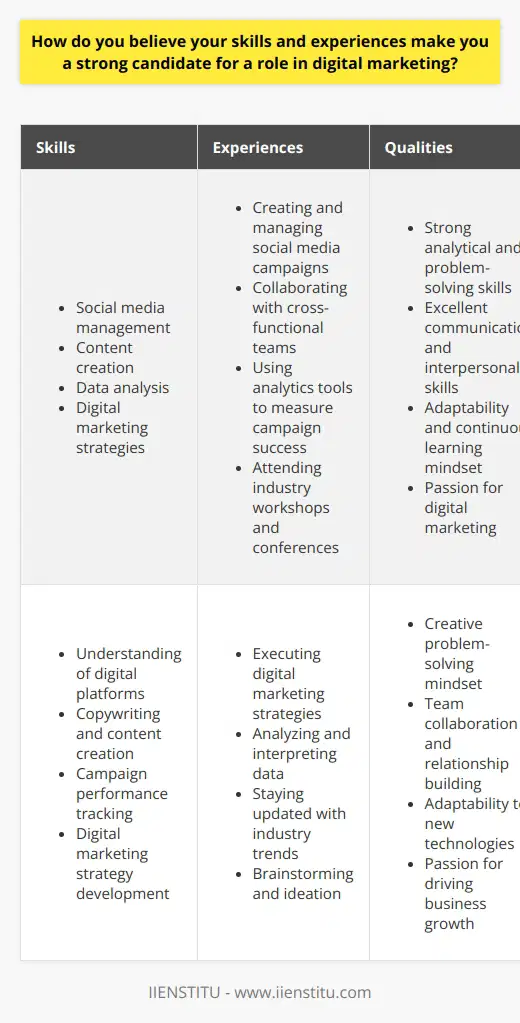
What inspired you to pursue a career in digital marketing?
My inspiration to pursue a career in digital marketing stems from several factors that have shaped my interests and aspirations. Growing up in the digital age, I have witnessed firsthand the transformative power of technology and its impact on the way businesses connect with their audiences. The dynamic nature of the digital landscape, coupled with the endless opportunities for creativity and innovation, has captivated my attention and fueled my desire to be a part of this exciting field.
The Allure of Creativity and Innovation
One of the primary reasons I am drawn to digital marketing is the opportunity to combine my creative skills with strategic thinking. The digital realm offers a vast canvas for marketers to craft compelling stories, design engaging visual content, and develop innovative campaigns that resonate with target audiences. The prospect of constantly pushing the boundaries of creativity and exploring new ways to capture attention in an increasingly competitive online space is both challenging and exhilarating.
The Power of Data-Driven Insights
Another aspect that inspired me to pursue digital marketing is the ability to leverage data and analytics to make informed decisions. In the digital age, marketers have access to a wealth of information about consumer behavior, preferences, and engagement patterns. The opportunity to dive deep into data, uncover valuable insights, and use them to optimize marketing strategies is incredibly appealing to me. The data-driven nature of digital marketing allows for a more targeted and personalized approach, ensuring that the right message reaches the right audience at the right time.
The Impact of Digital Marketing on Business Growth
Moreover, I am motivated by the significant impact that digital marketing can have on business growth and success. In today's highly connected world, a strong online presence is essential for brands to thrive and remain competitive. Digital marketing provides a cost-effective and measurable way to reach and engage with target audiences, build brand awareness, and drive conversions. The ability to contribute to the growth and success of businesses through strategic digital marketing initiatives is a fulfilling and rewarding aspect of this career path.
The Constant Evolution of the Digital Landscape
Furthermore, the ever-evolving nature of the digital landscape keeps me excited and motivated to continuously learn and adapt. The rapid pace of technological advancements, emerging platforms, and changing consumer behaviors present endless opportunities for growth and development. The need to stay updated with the latest trends, tools, and best practices in digital marketing ensures that every day brings new challenges and learning experiences. The dynamic nature of this field keeps me on my toes and fuels my passion for staying at the forefront of the industry.
Making a Positive Impact on Society
Lastly, I am inspired by the potential of digital marketing to make a positive impact on society. Digital platforms have the power to amplify important messages, raise awareness for social causes, and drive meaningful change. The ability to leverage digital marketing skills to support non-profit organizations, promote sustainability initiatives, or advocate for social justice issues is a fulfilling aspect of this career. The opportunity to use my skills and expertise to make a difference in the world is a significant driving force behind my pursuit of a career in digital marketing.
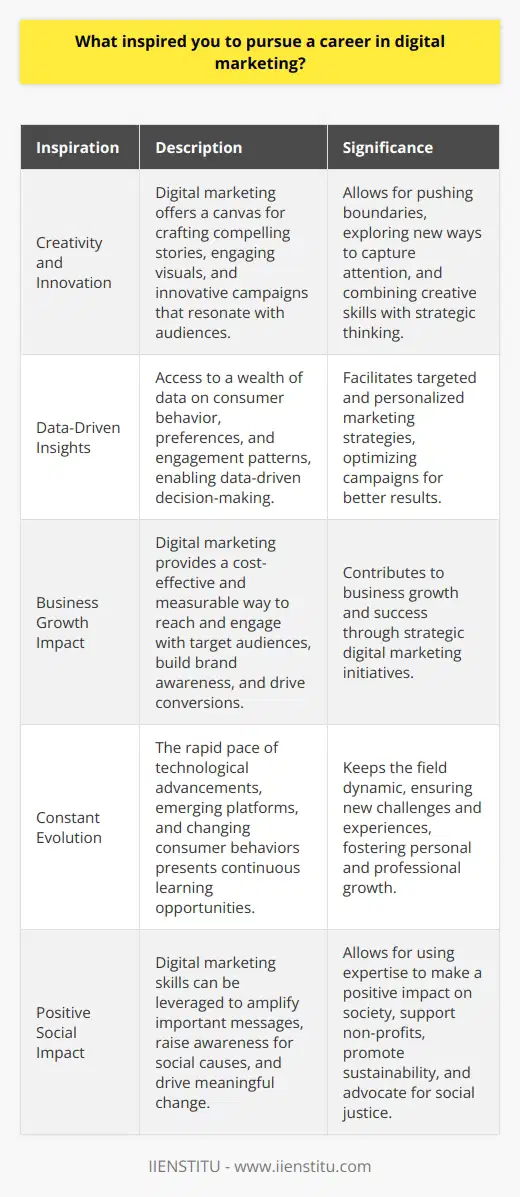
How do you stay up-to-date with the latest trends and best practices in the digital marketing industry?
Staying up-to-date with the latest trends and best practices in the digital marketing industry is crucial for success. Digital marketers must continuously educate themselves to stay ahead of the curve in this rapidly evolving field. One effective way to stay informed is by regularly reading industry blogs and publications. These resources provide valuable insights into emerging trends, case studies, and expert opinions. Attending conferences and webinars is another excellent method for staying current. These events offer opportunities to learn from thought leaders and network with peers. Engaging with industry communities on social media platforms like LinkedIn and Twitter can also help marketers stay connected and informed. Following influencers and participating in discussions can provide exposure to new ideas and perspectives. Additionally, experimenting with new tools and technologies allows marketers to gain hands-on experience and stay ahead of the competition. By adopting a proactive approach to learning and embracing change, digital marketers can effectively navigate the ever-evolving landscape of the industry.
The Importance of Continuous Learning
Continuous learning is essential for digital marketers to remain competitive and deliver results. The digital landscape is constantly changing, with new platforms, technologies, and consumer behaviors emerging regularly. Marketers who fail to adapt risk falling behind and losing relevance. Investing time in personal development and skill acquisition is necessary to stay ahead of the curve. This can involve taking online courses, attending workshops, or pursuing certifications. By actively seeking out learning opportunities, marketers can expand their knowledge base and develop new competencies. Continuous learning also helps marketers stay inspired and motivated. Exposure to fresh ideas and approaches can spark creativity and drive innovation. Ultimately, a commitment to ongoing education is a key factor in long-term success as a digital marketer.
Leveraging Industry Resources
One of the most accessible ways to stay informed about digital marketing trends is by leveraging industry resources. Numerous blogs, publications, and websites are dedicated to providing up-to-date information and insights. Some popular options include Search Engine Journal, Marketing Land, and Social Media Examiner. These platforms feature articles, case studies, and expert opinions on various aspects of digital marketing. By regularly reading these resources, marketers can gain exposure to new strategies, best practices, and emerging trends. Many of these websites also offer email newsletters, allowing marketers to have the latest content delivered directly to their inboxes. In addition to online resources, industry magazines and books can provide more in-depth coverage of specific topics. By curating a diverse range of informational sources, marketers can ensure they have a well-rounded understanding of the digital marketing landscape.
Engaging with Industry Communities
Engaging with industry communities is another valuable way to stay current in digital marketing. Social media platforms, particularly LinkedIn and Twitter, have vibrant communities of marketing professionals. By following thought leaders, joining relevant groups, and participating in discussions, marketers can gain exposure to new perspectives and ideas. These interactions can also lead to valuable networking opportunities and partnerships. Marketers can also join online forums and communities dedicated to specific aspects of digital marketing, such as SEO or social media advertising. These niche communities provide a space for marketers to ask questions, share experiences, and collaborate with like-minded professionals. Engaging with industry communities allows marketers to tap into collective knowledge and stay connected to the pulse of the industry.
Experimenting with New Tools and Technologies
Hands-on experience is a valuable complement to theoretical knowledge when it comes to staying current in digital marketing. Experimenting with new tools and technologies allows marketers to gain practical skills and stay ahead of the curve. This can involve testing out new social media platforms, trying different ad formats, or exploring emerging technologies like artificial intelligence and virtual reality. By actively experimenting, marketers can develop a deeper understanding of how these tools work and how they can be leveraged for marketing purposes. Experimentation also allows marketers to identify new opportunities and stay ahead of the competition. It's important to approach experimentation with a strategic mindset, setting clear goals and metrics to evaluate success. By combining hands-on experience with theoretical knowledge, marketers can develop a well-rounded skill set that allows them to adapt to the ever-changing digital landscape.
Conclusion
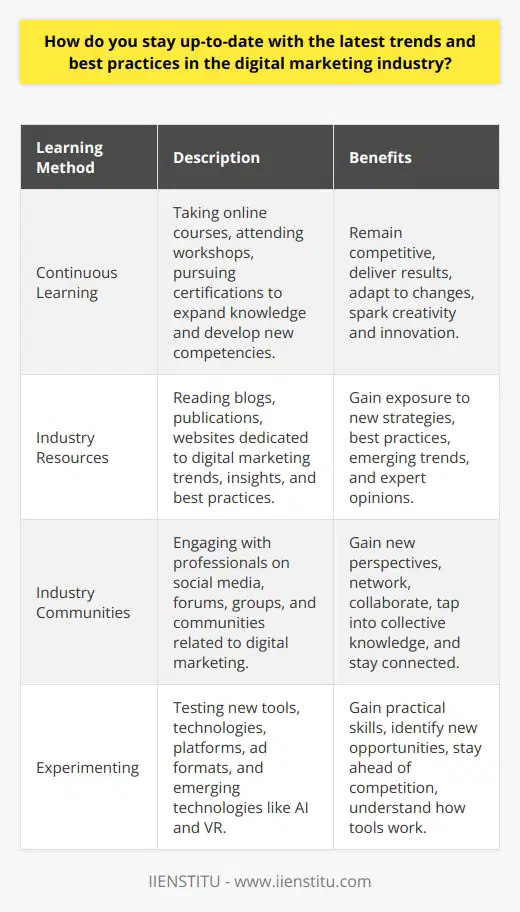
Can you describe a successful digital marketing campaign you have worked on and the strategies you employed?
One successful digital marketing campaign I worked on involved promoting a new e-commerce website for a fashion retailer. The primary objective was to increase brand awareness and drive traffic to the website. To achieve this, we implemented a multi-faceted strategy that incorporated various digital marketing channels.
Social Media Marketing
We launched a comprehensive social media campaign across Facebook, Instagram, and Twitter. This included creating engaging content, such as product showcases, style tips, and behind-the-scenes footage. We also collaborated with fashion influencers to reach a wider audience and build trust.
Influencer Partnerships
Partnering with influencers in the fashion niche helped us tap into their established follower base. These influencers created sponsored posts, stories, and videos featuring our client's products. This exposure led to increased brand recognition and website visits.
Search Engine Optimization (SEO)
To improve the website's visibility in search engine results, we implemented an SEO strategy. This involved conducting keyword research to identify high-traffic terms related to the fashion industry. We optimized the website's content, meta tags, and structure to align with these keywords.
On-Page Optimization
We ensured that each page on the website had unique, keyword-rich titles and descriptions. The content was optimized to provide value to the target audience while naturally incorporating relevant keywords. We also improved the website's navigation and speed to enhance user experience.
Pay-Per-Click (PPC) Advertising
To drive targeted traffic to the website, we launched a PPC campaign on Google Ads. We created compelling ad copy and targeted relevant keywords. The campaign was continuously monitored and optimized based on performance data to maximize return on investment (ROI).
Retargeting Ads
We implemented a retargeting campaign to reach users who had previously visited the website. These ads were displayed on various platforms, reminding potential customers of the products they had shown interest in. Retargeting helped increase brand recall and encourage conversions.
Email Marketing
To nurture leads and retain customers, we developed an email marketing strategy. We segmented the email list based on subscriber preferences and behavior. Personalized email campaigns were created, featuring new product launches, exclusive promotions, and style guides.
Results and Key Takeaways
The campaign was highly successful, resulting in a significant increase in website traffic and sales. Key takeaways include the importance of a multi-channel approach, targeting the right audience, and continuously monitoring and optimizing campaigns based on data insights.
By leveraging a combination of social media, influencer partnerships, SEO, PPC advertising, and email marketing, we created a comprehensive digital marketing campaign. This approach allowed us to reach a wide audience, build brand awareness, and drive conversions for the fashion retailer.

What are the key components of a successful digital marketing strategy?
A successful digital marketing strategy encompasses several key components that work together to achieve business objectives. These components include a well-defined target audience, clear goals and objectives, and a comprehensive approach to reaching and engaging potential customers through various digital channels. Let's explore each of these components in more detail.
Defining Your Target Audience
The foundation of any successful digital marketing strategy is a deep understanding of your target audience. This involves conducting thorough market research to identify the demographics, interests, behaviors, and pain points of your ideal customer. By creating detailed buyer personas, you can tailor your marketing messages and tactics to resonate with your audience effectively.
Conducting Market Research
To gain insights into your target audience, utilize various market research techniques such as surveys, focus groups, and online analytics tools. Analyze customer data, social media interactions, and website behavior to uncover valuable information about your audience's preferences and needs.
Creating Buyer Personas
Based on the data collected, develop detailed buyer personas that represent your ideal customers. Include information such as age, gender, location, income level, interests, and challenges they face. These personas will guide your marketing efforts and ensure that your messaging resonates with your target audience.
Setting Clear Goals and Objectives
A successful digital marketing strategy requires well-defined goals and objectives that align with your overall business objectives. These goals should be specific, measurable, achievable, relevant, and time-bound (SMART). By setting clear targets, you can track your progress and make data-driven decisions to optimize your strategy.
Defining SMART Goals
When setting goals for your digital marketing strategy, ensure they meet the SMART criteria. For example, a SMART goal could be: "Increase website traffic by 25% within the next quarter through targeted social media campaigns and search engine optimization efforts."
Aligning with Business Objectives
Your digital marketing goals should contribute to the overall success of your business. Align your objectives with key performance indicators (KPIs) such as revenue growth, lead generation, customer acquisition, and brand awareness. Regularly monitor and adjust your goals based on performance data and changing business needs.
Developing a Comprehensive Approach
A successful digital marketing strategy leverages various channels and tactics to reach and engage your target audience effectively. This comprehensive approach includes content marketing, search engine optimization (SEO), social media marketing, email marketing, and paid advertising.
Content Marketing
Develop valuable, relevant, and consistent content that attracts, informs, and engages your target audience. Create blog posts, videos, infographics, and other forms of content that address your audience's needs and establish your brand as a thought leader in your industry.
Search Engine Optimization (SEO)
Optimize your website and content for search engines to improve your visibility and attract organic traffic. Conduct keyword research, optimize your website's structure and metadata, and build high-quality backlinks to enhance your search engine rankings.
Social Media Marketing
Leverage social media platforms to connect with your target audience, build brand awareness, and drive engagement. Develop a social media content strategy that aligns with your overall marketing goals and post regularly to keep your audience engaged.
Email Marketing
Build an email list of subscribers interested in your brand and nurture them with valuable content and promotions. Segment your email list based on subscriber preferences and behaviors to deliver targeted and personalized messages that drive conversions.
Paid Advertising
Complement your organic marketing efforts with paid advertising campaigns on platforms like Google Ads, Facebook Ads, and LinkedIn Ads. Use targeting options to reach your desired audience and drive qualified traffic to your website or landing pages.
By incorporating these key components into your digital marketing strategy, you can effectively reach and engage your target audience, achieve your business goals, and establish a strong online presence. Remember to continuously monitor, analyze, and adapt your strategy based on performance data to ensure ongoing success.

How can I effectively measure the ROI of my digital marketing campaigns?
Measuring the ROI of digital marketing campaigns is crucial for optimizing performance and allocating resources effectively. To accurately calculate ROI, begin by setting clear, measurable goals aligned with your business objectives. Identify key performance indicators (KPIs) such as conversion rates, customer acquisition costs, and customer lifetime value. Implement robust tracking systems to monitor user behavior and attribute conversions to specific marketing channels and campaigns.
Establish Clear Goals and KPIs
Define specific, measurable goals for each digital marketing campaign. These goals should contribute to your overall business objectives. Common goals include increasing website traffic, generating leads, boosting sales, or improving brand awareness. Assign relevant KPIs to each goal to track progress and measure success.
Examples of KPIs:
Conversion rate
Cost per acquisition (CPA)
Return on ad spend (ROAS)
Customer lifetime value (CLV)
Engagement metrics (e.g., clicks, shares, comments)
Implement Comprehensive Tracking
Set up robust tracking systems to monitor user behavior and attribute conversions accurately. Use tools like Google Analytics, Facebook Pixel, or Adobe Analytics to track website visits, page views, and conversions. Implement UTM parameters to identify traffic sources and measure the effectiveness of specific campaigns. Ensure proper tracking across all marketing channels, including social media, email, and paid advertising.
Analyze and Optimize Performance
Regularly review and analyze campaign performance data. Compare actual results against your predefined goals and KPIs. Identify top-performing channels, ad creatives, and targeting strategies. Allocate more resources to campaigns that generate the highest ROI. Continuously test and optimize your marketing efforts based on data-driven insights.
Optimization Techniques:
A/B testing ad creatives and landing pages
Refining audience targeting
Adjusting bid strategies
Personalizing content and offers
Improving website user experience
Consider Long-Term ROI
Evaluate the long-term impact of your digital marketing campaigns. measure customer lifetime value to understand the total revenue generated from a customer acquired through a specific campaign. Factor in retention rates and repeat purchases when calculating ROI. Invest in building long-term customer relationships to maximize lifetime value and overall campaign profitability.
Utilize Marketing Attribution Models
Implement marketing attribution models to assign credit to different touchpoints in the customer journey. Use models like first-touch, last-touch, or multi-touch attribution to understand the impact of each marketing channel. Attribution models help you allocate budgets effectively and optimize campaigns based on their contribution to conversions.
By setting clear goals, implementing comprehensive tracking, analyzing performance, considering long-term ROI, and utilizing attribution models, you can effectively measure the ROI of your digital marketing campaigns. Continuously monitor, test, and optimize your strategies to maximize returns and drive business growth.

What are some best practices for creating engaging content in digital marketing?
Creating engaging content is crucial for the success of digital marketing campaigns. To capture and retain the audience's attention, marketers should focus on several best practices. First, understanding the target audience is essential to create content that resonates with their interests and needs. Conducting thorough research and analyzing audience demographics, preferences, and behavior patterns help in tailoring content effectively.
Next, crafting compelling headlines and titles is vital to attract readers and encourage them to click through. Headlines should be concise, descriptive, and enticing, while accurately representing the content within. Utilizing power words, numbers, and emotional triggers can enhance the impact of headlines and improve click-through rates.
Formatting for Readability
Formatting plays a significant role in making content engaging and easy to consume. Breaking up long paragraphs into shorter, digestible chunks improves readability and maintains the audience's attention. Using subheadings, bullet points, and numbered lists helps organize information and allows readers to scan the content quickly.
Incorporating Visuals
Visuals are powerful tools for capturing attention and conveying messages effectively. Incorporating relevant images, infographics, videos, and other multimedia elements enhances the appeal of content and breaks up text-heavy sections. Visuals should be high-quality, visually appealing, and align with the content's theme and tone.
Storytelling and Emotional Connection
Engaging content often relies on storytelling techniques to establish an emotional connection with the audience. Sharing personal experiences, case studies, or real-life examples helps humanize the brand and creates a sense of relatability. Emotions drive decision-making, so evoking the right emotions through content can lead to increased engagement and conversions.
Providing Value
Ultimately, engaging content must provide value to the audience. Whether it's educational, informative, entertaining, or problem-solving, the content should offer something worthwhile to the reader. Conducting research to identify the audience's pain points, challenges, and desires allows marketers to create content that addresses their needs and provides practical solutions.
Encouraging Interaction
Engaging content should encourage interaction and participation from the audience. Including calls-to-action (CTAs), asking questions, and prompting discussions in the comments section fosters a sense of community and encourages active engagement. Responding to comments and facilitating conversations further strengthens the bond between the brand and its audience.
Optimizing for Search Engines
To ensure content reaches its intended audience, optimizing it for search engines is crucial. Conducting keyword research and strategically incorporating relevant keywords throughout the content improves its visibility in search results. However, it's important to prioritize readability and user experience over keyword stuffing.
Measuring and Analyzing Performance
Regularly measuring and analyzing the performance of content is essential for refining and improving digital marketing strategies. Tracking metrics such as views, shares, comments, and conversion rates provides valuable insights into what resonates with the audience. Based on these insights, marketers can adapt their content strategies to maximize engagement and achieve their desired outcomes.
By implementing these best practices consistently, digital marketers can create engaging content that captivates their target audience, builds brand loyalty, and drives meaningful interactions. Engaging content is the foundation of successful digital marketing campaigns, as it helps establish trust, credibility, and long-lasting relationships with customers.
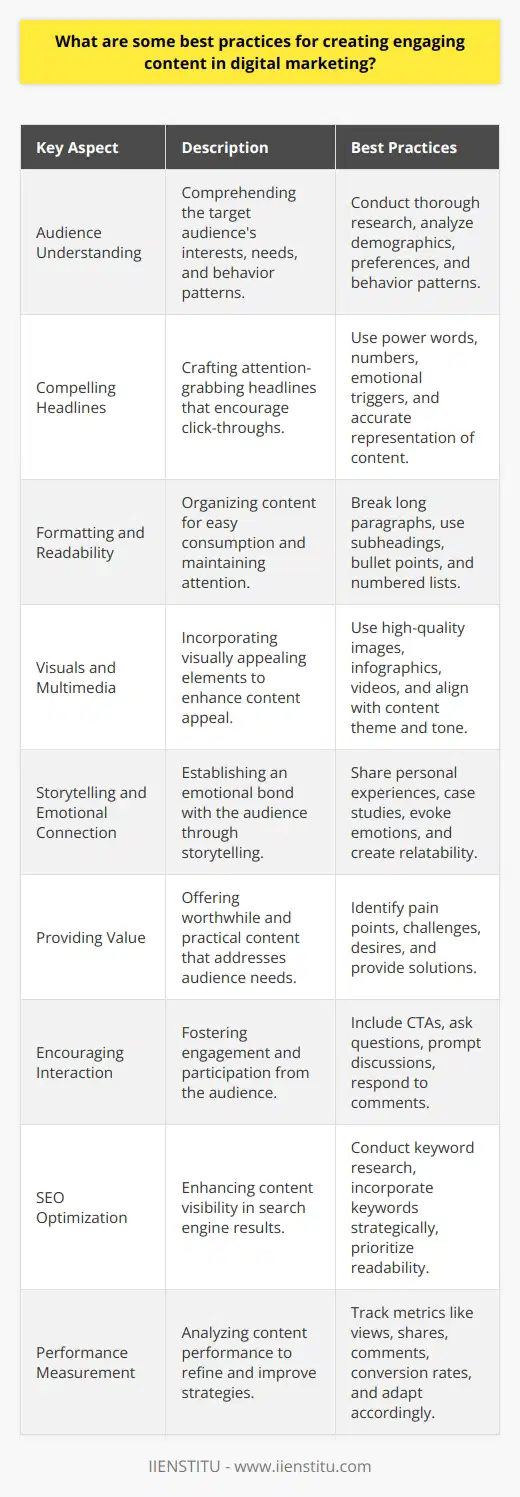
What are the most important skills for a successful digital marketing manager?
A successful digital marketing manager must possess a diverse set of skills to navigate the ever-evolving digital landscape effectively. The most crucial skills include a deep understanding of digital marketing strategies, strong analytical abilities, excellent communication skills, and adaptability to change. A digital marketing manager should be well-versed in various digital marketing channels, such as social media, email marketing, search engine optimization (SEO), and pay-per-click (PPC) advertising.
Understanding Digital Marketing Strategies
A digital marketing manager must have a comprehensive understanding of digital marketing strategies and how they work together. They should be able to develop and execute multi-channel campaigns that align with the overall marketing objectives. This involves setting clear goals, identifying target audiences, and creating engaging content that resonates with the intended audience.
Analytical Skills
Strong analytical skills are essential for a digital marketing manager to measure the success of campaigns and make data-driven decisions. They should be comfortable working with various analytics tools, such as Google Analytics, to track key performance indicators (KPIs) and generate meaningful insights. By analyzing data, a digital marketing manager can optimize campaigns, allocate resources efficiently, and improve overall marketing performance.
Interpreting Data
A digital marketing manager must be able to interpret data and translate it into actionable insights for stakeholders. They should be able to present complex data in a clear and concise manner, highlighting the most important findings and their implications for the business.
Communication Skills
Excellent communication skills are crucial for a digital marketing manager to effectively collaborate with internal teams and external partners. They should be able to articulate ideas clearly, both verbally and in writing, and adapt their communication style to different audiences. A digital marketing manager must also be able to build strong relationships with stakeholders, including clients, colleagues, and vendors.
Collaboration and Leadership
A digital marketing manager often leads a team of specialists, such as content creators, social media managers, and data analysts. They must be able to foster a collaborative environment, delegate tasks effectively, and provide guidance and support to team members. Strong leadership skills are essential to motivate the team and ensure projects are completed on time and within budget.
Adaptability to Change
The digital marketing landscape is constantly evolving, with new technologies, platforms, and consumer behaviors emerging regularly. A successful digital marketing manager must be adaptable to change and stay up-to-date with the latest industry trends and best practices. They should be proactive in learning new skills and tools, and be willing to experiment with new strategies to stay ahead of the competition.
Continuous Learning
A digital marketing manager should embrace a mindset of continuous learning and seek opportunities to expand their knowledge and skills. This can include attending industry conferences, participating in online courses, and reading relevant publications to stay informed about the latest developments in digital marketing.
Creativity and Innovation
While data and analytics are essential, a digital marketing manager should also possess creativity and innovation to develop unique and compelling campaigns. They should be able to think outside the box and come up with fresh ideas that capture the attention of the target audience and differentiate the brand from competitors.
In conclusion, a successful digital marketing manager must have a diverse skill set that combines technical knowledge, analytical abilities, communication skills, adaptability, and creativity. By continually developing these skills and staying updated with industry trends, a digital marketing manager can effectively lead their team and drive successful digital marketing campaigns that deliver measurable results for the business.

How do you stay up-to-date with the latest digital marketing trends and best practices?
Staying up-to-date with the latest digital marketing trends and best practices is crucial for marketers in today's fast-paced digital landscape. One effective approach is to regularly read industry blogs and publications, such as Search Engine Journal, Marketing Land, and Social Media Examiner. These sources provide valuable insights into emerging trends, case studies, and expert opinions on various digital marketing topics.
Attending industry conferences and webinars is another excellent way to stay informed. Events like Content Marketing World, MozCon, and Social Media Marketing World bring together thought leaders and practitioners to share their knowledge and experiences. These gatherings offer opportunities to learn from experts, network with peers, and discover new tools and strategies.
Engaging with Digital Marketing Communities
Engaging with online communities focused on digital marketing is also beneficial. Platforms like LinkedIn, Twitter, and Facebook have numerous groups and pages dedicated to discussing the latest trends and best practices. Participating in these communities allows marketers to ask questions, share insights, and learn from the collective knowledge of their peers.
Following influential digital marketers and thought leaders on social media is another way to stay current. Many experts regularly share their opinions, predictions, and analyses of the latest developments in the field. By engaging with their content and joining the conversations, marketers can gain valuable perspectives and ideas.
Experimenting with New Techniques and Tools
Staying up-to-date also involves experimenting with new techniques and tools. As digital marketing evolves, new platforms, technologies, and strategies emerge. Marketers should be willing to test and adopt new approaches to see what works best for their specific goals and audiences. This may involve trying out new social media platforms, experimenting with emerging content formats, or leveraging the latest advertising features.
Analyzing Competitor Strategies
Analyzing the strategies and tactics of successful competitors can provide valuable insights into current best practices. By studying how other brands in their industry are leveraging digital marketing, marketers can identify effective techniques and adapt them to their own campaigns. This may involve examining competitors' content strategies, social media presence, advertising campaigns, and customer engagement efforts.
Continuously Measuring and Optimizing Performance
Finally, staying up-to-date requires continuously measuring and optimizing the performance of digital marketing efforts. By regularly analyzing data and metrics, marketers can identify what's working and what needs improvement. This data-driven approach allows them to refine their strategies, allocate resources more effectively, and stay ahead of the curve in an ever-changing digital landscape.

Can you describe a challenging digital marketing campaign you managed and how you overcame any obstacles?
One challenging digital marketing campaign I managed involved promoting a new software product to a niche audience. The primary obstacle was crafting a message that resonated with the target market while differentiating our product from competitors. To overcome this challenge, I conducted extensive market research to gain insights into the audience's pain points and preferences.
Based on the research findings, I developed a multi-channel marketing strategy that included targeted content marketing, social media advertising, and email campaigns. I collaborated with the product development team to create compelling content that highlighted the unique features and benefits of our software. We also leveraged customer testimonials and case studies to build credibility and trust with potential customers.
Optimizing the Campaign
Throughout the campaign, I closely monitored key performance indicators such as website traffic, conversion rates, and engagement metrics. I used this data to continuously optimize our tactics and allocate resources to the most effective channels. For example, when I noticed that our social media ads were generating high click-through rates but low conversions, I adjusted the landing page copy and design to better align with the ad messaging.
Addressing Technical Challenges
Another challenge we faced was technical issues with our website during the launch of the campaign. I quickly assembled a team of developers and IT professionals to identify and resolve the problems. We implemented a contingency plan to minimize downtime and ensure that potential customers could still access information about our product.
Collaborating with Stakeholders
Effective communication and collaboration with internal stakeholders were crucial to the success of the campaign. I regularly updated the sales and customer service teams on the campaign's progress and provided them with the necessary resources to handle inquiries and convert leads. I also worked closely with the executive team to secure additional budget and resources when needed.
Measuring and Reporting Results
To measure the success of the campaign, I tracked key metrics such as lead generation, customer acquisition costs, and revenue growth. I used this data to create comprehensive reports for the leadership team, highlighting the campaign's ROI and identifying areas for improvement. The campaign ultimately exceeded our initial goals, generating a significant number of qualified leads and contributing to the overall growth of the business.
Lessons Learned
Managing this challenging digital marketing campaign taught me the importance of adaptability, data-driven decision making, and effective collaboration. It also reinforced the value of understanding your target audience and tailoring your messaging and tactics accordingly. By staying focused on the end goal and being willing to pivot when necessary, I was able to overcome obstacles and deliver successful results for the company.

How do you ensure that your content aligns with your overall digital marketing strategy?
Ensuring that your blog post content aligns with your overall digital marketing strategy is crucial for success. To achieve this, you must first have a clear understanding of your target audience and their needs. Conduct thorough research to identify the topics and keywords that resonate with your audience. This will help you create content that not only attracts their attention but also provides value.
Set Clear Goals and Objectives
Before creating any content, set clear goals and objectives that align with your digital marketing strategy. Determine what you want to achieve with each blog post, whether it's increasing brand awareness, driving traffic, or generating leads. Having specific goals in mind will help you stay focused and create content that supports your overall strategy.
Develop a Content Plan
Create a content plan that outlines the topics, keywords, and formats for your blog posts. Ensure that each piece of content fits into your overall marketing strategy and contributes to achieving your goals. A well-structured content plan will help you maintain consistency and ensure that your blog posts are aligned with your brand's message and values.
Optimize for Search Engines
To maximize the reach of your blog posts, optimize them for search engines. Use relevant keywords in your titles, headings, and throughout the content. However, avoid keyword stuffing, as it can negatively impact your search engine rankings. Instead, focus on creating high-quality, informative content that naturally incorporates your target keywords.
Promote Your Content
Once you've created your blog post, promote it through various channels to reach your target audience. Share it on social media platforms, include it in your email newsletters, and reach out to influencers or other websites for backlinks. Effective promotion will help drive traffic to your blog and increase its visibility, supporting your overall digital marketing strategy.
Analyze and Adjust
Regularly analyze the performance of your blog posts using tools like Google Analytics. Monitor metrics such as traffic, engagement, and conversion rates to determine the effectiveness of your content. Use this data to make informed decisions and adjust your content strategy as needed. Continuously refining your approach will ensure that your blog posts remain aligned with your digital marketing goals.
Collaborate with Your Team
Collaborate with your marketing team to ensure that your blog content aligns with other aspects of your digital marketing strategy. Work closely with your SEO specialists, social media managers, and email marketing team to create a cohesive and integrated approach. Regular communication and collaboration will help you maintain consistency and maximize the impact of your blog posts.
By following these steps and consistently creating valuable, targeted content, you can ensure that your blog posts effectively support and align with your overall digital marketing strategy. Remember to stay focused on your goals, monitor your progress, and adapt as needed to achieve the best results.
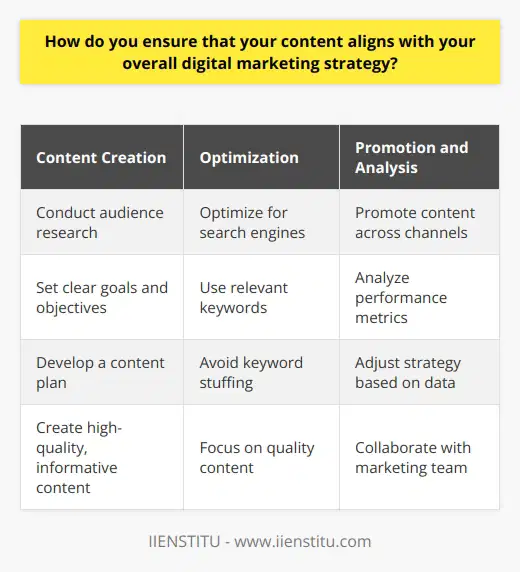
What steps do you take to create a content calendar that supports your digital marketing goals?
Creating a content calendar that supports your digital marketing goals requires careful planning and execution. Begin by defining your objectives, such as increasing brand awareness, generating leads, or driving sales. Conduct thorough research to identify your target audience, their preferences, and the platforms they frequent. Use this information to determine the types of content that will resonate with your audience and align with your goals.
Establish a Content Mix
Develop a diverse content mix that includes blog posts, videos, infographics, and social media updates. Ensure that each piece of content serves a specific purpose and contributes to your overall objectives. Consider the optimal frequency for publishing each type of content based on your resources and audience engagement.
Identify Key Dates and Events
Identify important dates and events relevant to your industry or target audience. These may include holidays, product launches, or industry conferences. Plan your content around these dates to capitalize on increased interest and engagement.
Collaborate with Your Team
Involve your team members in the content planning process to gather diverse ideas and perspectives. Assign responsibilities for content creation, editing, and distribution to ensure a smooth workflow. Use collaboration tools to keep everyone informed and on track.
Use a Content Calendar Template
Utilize a content calendar template to organize your ideas and schedule your content. Many templates are available online, or you can create your own using a spreadsheet or specialized software. Include fields for the content title, format, target audience, publication date, and distribution channels.
Plan for Content Promotion
In addition to planning your content creation, also consider how you will promote each piece. Identify the social media platforms, email campaigns, and paid advertising strategies you will use to amplify your content's reach. Include these promotion tasks in your content calendar to ensure they are executed in a timely manner.
Allow for Flexibility
While a content calendar provides structure, it's essential to allow for flexibility. Leave room for timely content that addresses current events or industry trends. Be prepared to adjust your calendar if needed to accommodate changes in your marketing strategy or audience preferences.
Monitor and Analyze Performance
Regularly monitor the performance of your content using analytics tools. Track metrics such as views, engagement, and conversions. Use this data to identify successful content types and topics, as well as areas for improvement. Continuously refine your content calendar based on these insights to optimize your digital marketing efforts.
Conclusion
By following these steps and continuously iterating based on performance data, you can create a content calendar that effectively supports your digital marketing goals. Remember to prioritize quality over quantity and always keep your target audience's needs and preferences at the forefront of your content planning efforts.
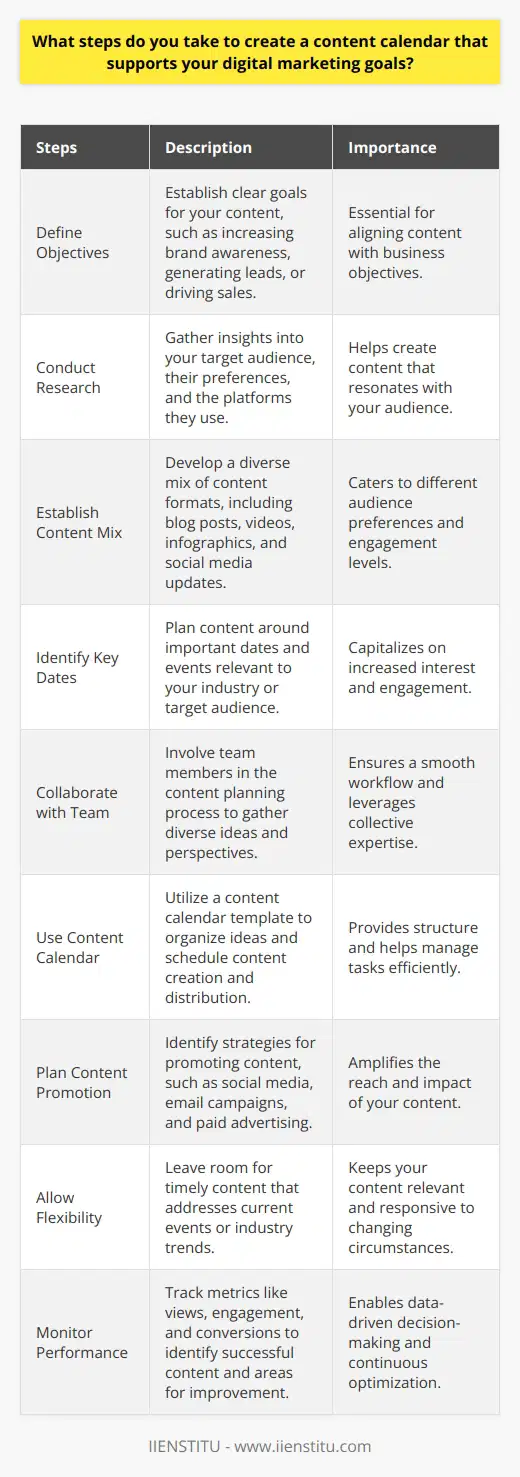
In what ways do you measure the effectiveness of your content in achieving your digital marketing objectives?
Measuring the effectiveness of your content in achieving digital marketing objectives is crucial for optimizing your strategy. Several key performance indicators (KPIs) can help you gauge the success of your blog post.
Engagement Metrics
Engagement metrics provide valuable insights into how your audience interacts with your content. These metrics include:
Time on Page
Analyze the average time users spend reading your blog post. Longer durations indicate higher engagement and interest.
Bounce Rate
Examine the percentage of visitors who leave your website after viewing only one page, including your blog post.
Comments and Shares
Monitor the number of comments and shares your blog post receives on various platforms. High numbers suggest resonance with readers.
Traffic Sources
Identify the sources driving traffic to your blog post. This information helps you understand your audience's behavior.
Organic Search
Measure the amount of traffic coming from search engines. High organic traffic indicates effective search engine optimization (SEO).
Social Media
Track the traffic generated from social media platforms. This metric reflects the success of your social media promotion efforts.
Referral Links
Analyze the traffic originating from other websites linking to your blog post. Referral links signify your content's authority and relevance.
Conversion Rates
Conversion rates directly correlate to your digital marketing objectives. They measure the percentage of visitors taking desired actions.
Call-to-Action (CTA) Clicks
Calculate the number of clicks on CTAs within your blog post. High click-through rates indicate compelling and well-placed CTAs.
Lead Generation
Determine the number of leads generated from your blog post. This metric assesses the effectiveness of your content in attracting potential customers.
Sales and Revenue
Evaluate the impact of your blog post on sales and revenue. Attribute conversions and revenue to specific blog posts when possible.
Retention and Loyalty
Measure how your blog post contributes to retaining and building loyalty among your audience.
Return Visitors
Analyze the percentage of visitors who return to your website after reading your blog post. High return rates indicate valuable content.
Subscription Growth
Track the increase in email or newsletter subscriptions after publishing your blog post. Growing subscriptions signify a loyal reader base.
By monitoring these KPIs, you can assess the effectiveness of your blog post in achieving your digital marketing goals. Regular analysis and optimization based on these metrics will help you refine your content strategy and drive better results.
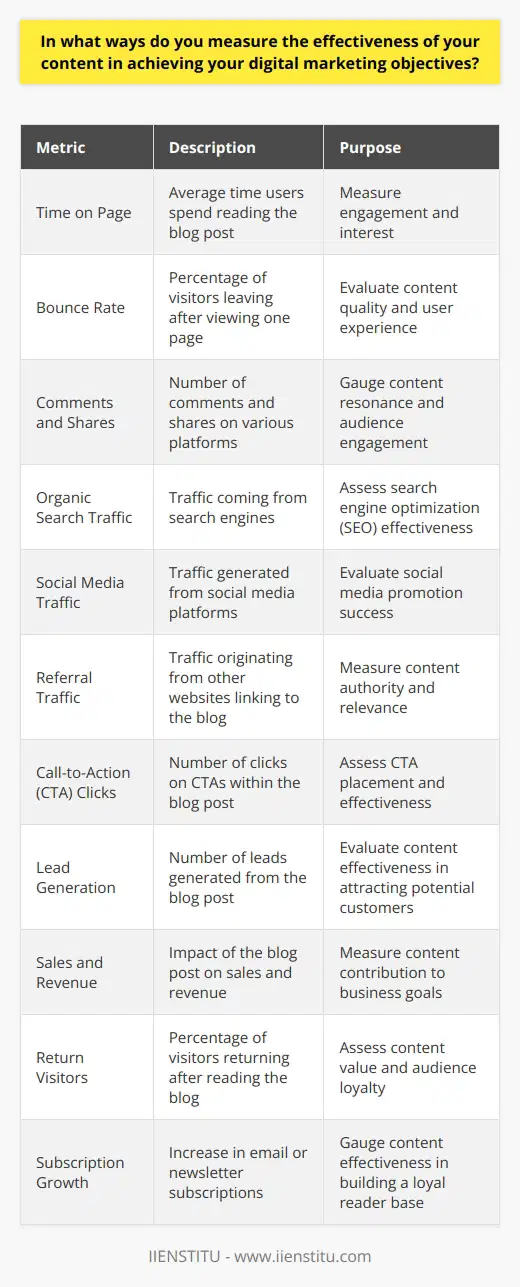
What are some common digital marketing interview questions and their recommended answers?
Digital marketing interviews often cover a range of topics, from technical skills to strategic thinking and problem-solving abilities. Some common questions include discussing the candidate's experience with various digital marketing channels, such as social media, email marketing, and search engine optimization (SEO). Interviewers may ask about the candidate's approach to developing and executing digital marketing campaigns, as well as their ability to analyze and interpret data to inform decision-making. Other questions may focus on the candidate's knowledge of industry trends, best practices, and tools.
Experience with Digital Marketing Channels
When asked about experience with specific digital marketing channels, candidates should provide concrete examples of their work. They should discuss the strategies they employed, the challenges they faced, and the results they achieved. For instance, if discussing social media marketing, a candidate might talk about a successful campaign they ran on Facebook or Instagram, highlighting the tactics they used to engage their target audience and drive conversions.
Developing and Executing Digital Marketing Campaigns
Candidates should be prepared to discuss their process for developing and executing digital marketing campaigns. This may include discussing how they identify target audiences, set campaign goals, and choose the appropriate channels and tactics. They should also be able to talk about how they measure and optimize campaign performance over time. A strong answer might include an example of a campaign the candidate worked on from start to finish, showcasing their strategic thinking and execution skills.
Analyzing and Interpreting Data
Data analysis is a critical component of digital marketing, and candidates should be prepared to discuss their experience in this area. They should be able to talk about the metrics they use to measure campaign success, as well as the tools and techniques they employ to collect, analyze, and visualize data. A strong answer might include an example of how the candidate used data to identify opportunities for improvement in a campaign, and the steps they took to optimize performance based on their findings.
Industry Knowledge and Best Practices
Interviewers may also ask questions to gauge a candidate's knowledge of digital marketing industry trends and best practices. Candidates should stay up-to-date on the latest developments in the field, and be prepared to discuss how they stay informed and apply this knowledge to their work. They may also be asked about their experience with specific tools and platforms, such as Google Analytics, AdWords, or marketing automation software.
Problem-Solving and Strategic Thinking
Finally, interviewers may pose hypothetical scenarios or ask case-style questions to assess a candidate's problem-solving and strategic thinking abilities. Candidates should be prepared to think on their feet and provide well-reasoned, data-driven responses. A strong answer might include a systematic approach to breaking down the problem, identifying key considerations and trade-offs, and proposing a solution that aligns with business goals and customer needs.
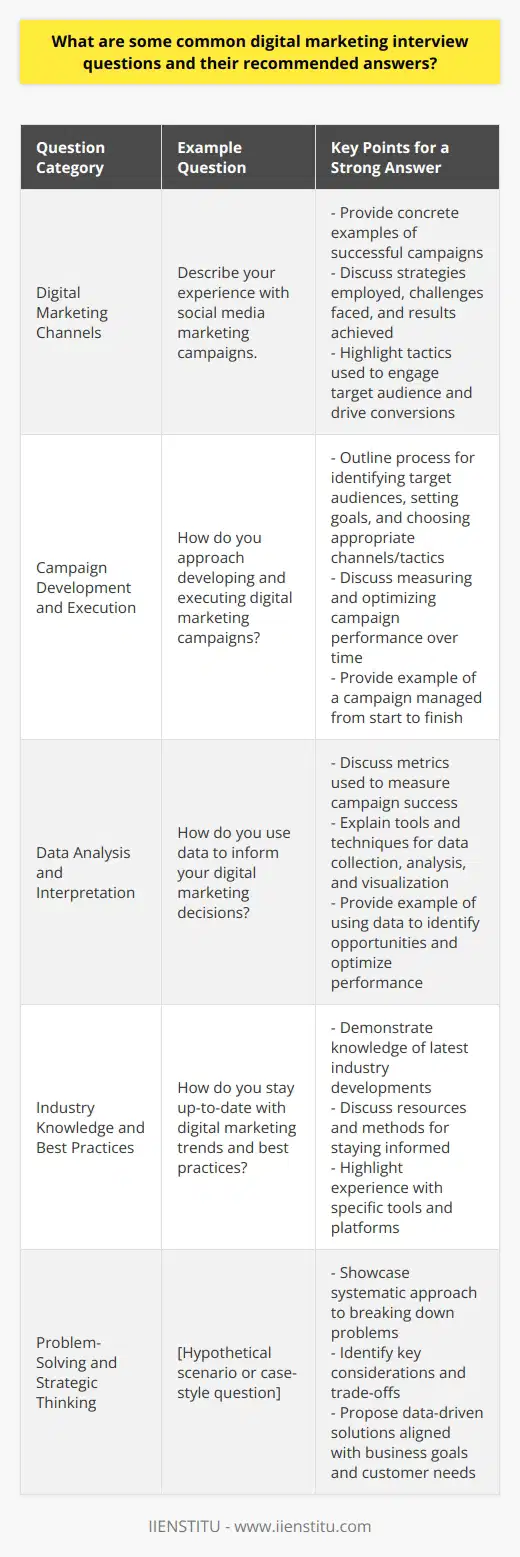
How can I prepare for a digital marketing interview to showcase my skills and knowledge?
Preparing for a digital marketing interview requires a strategic approach to showcase your skills and knowledge effectively. First, research the company and the specific role you are applying for to tailor your responses accordingly. Review the job description carefully and identify the key qualifications and responsibilities mentioned. Make a list of your relevant skills, experiences, and achievements that align with the requirements of the position.
Understand the Industry
To demonstrate your expertise in digital marketing, you must have a deep understanding of the industry. Stay up-to-date with the latest trends, technologies, and best practices in digital marketing. Read industry blogs, attend webinars, and participate in online courses to expand your knowledge. Familiarize yourself with common digital marketing terms, concepts, and strategies.
Prepare Examples and Case Studies
Develop a portfolio of your digital marketing projects and campaigns. Select the most relevant and impactful examples that highlight your skills and achievements. Prepare case studies that demonstrate your ability to solve problems, drive results, and deliver ROI. Be ready to discuss the objectives, strategies, and outcomes of each project in detail.
Analyze Your Performance Metrics
Quantify your achievements using relevant performance metrics such as website traffic, conversion rates, and ROI. Use data to support your claims and showcase your ability to drive meaningful results. Prepare to explain how you tracked, analyzed, and optimized your campaigns based on these metrics.
Practice Your Communication Skills
Effective communication is crucial in any interview. Practice articulating your thoughts clearly and concisely. Use specific examples to illustrate your points and avoid generalities. Prepare answers to common interview questions, such as describing your strengths, weaknesses, and reasons for applying. Anticipate questions related to digital marketing and rehearse your responses.
Highlight Your Unique Value Proposition
Identify what sets you apart from other candidates. Emphasize your unique skills, experiences, or perspectives that can benefit the company. Demonstrate your passion for digital marketing and your desire to contribute to the organization's success. Show enthusiasm and a willingness to learn and grow within the role.
Prepare Questions for the Interviewer
Engage in a two-way conversation by preparing thoughtful questions for the interviewer. Ask about the company's digital marketing strategies, challenges, and goals. Inquire about the team structure, culture, and opportunities for professional development. Showing genuine interest in the company demonstrates your enthusiasm and research skills.
Conclusion
By following these steps, you can effectively prepare for a digital marketing interview and showcase your skills and knowledge. Remember to tailor your approach based on the specific company and role. Be confident, authentic, and showcase your passion for digital marketing. With proper preparation and practice, you can increase your chances of making a positive impression and landing the job.

What are the most important concepts and strategies to understand for a digital marketing interview?
Digital marketing interviews assess a candidate's knowledge of essential concepts and strategies crucial for successful online marketing campaigns. Interviewees should demonstrate a deep understanding of search engine optimization (SEO) principles, including keyword research and on-page optimization techniques. They must also be well-versed in pay-per-click (PPC) advertising, particularly Google Ads, and be able to create and manage effective campaigns.
Social media marketing is another critical aspect of digital marketing that candidates should be familiar with. They should know how to develop engaging content, grow followers, and analyze social media metrics. Email marketing is also essential, and interviewees should understand how to create compelling email campaigns and measure their success.
Content Marketing
Content marketing is a fundamental component of digital marketing, and candidates should be able to develop and execute content strategies. They should know how to create valuable, informative, and engaging content that resonates with the target audience. Additionally, they should be familiar with content management systems (CMS) and understand how to optimize content for search engines.
Analytics and Metrics
Digital marketing professionals must be data-driven and comfortable working with analytics tools like Google Analytics. They should know how to track and interpret key performance indicators (KPIs) such as website traffic, bounce rates, and conversion rates. Candidates should also be able to use data to make informed decisions and optimize marketing campaigns for better results.
Mobile Marketing
With the increasing use of mobile devices, digital marketers must understand mobile marketing strategies. This includes creating mobile-friendly websites, developing mobile apps, and using SMS and push notifications for marketing purposes. Interviewees should also be aware of the importance of mobile search optimization and how to create content that performs well on mobile devices.
Marketing Automation
Marketing automation tools help streamline and optimize digital marketing efforts. Candidates should be familiar with popular marketing automation platforms such as HubSpot, Marketo, and Pardot. They should understand how to use these tools to create and manage email campaigns, lead nurturing workflows, and lead scoring systems.
In addition to these technical skills, digital marketing interviewees should also possess strong communication and problem-solving abilities. They should be able to articulate their thoughts clearly and collaborate effectively with cross-functional teams. Ultimately, a successful digital marketer must be adaptable, creative, and continually staying up-to-date with the latest industry trends and best practices.
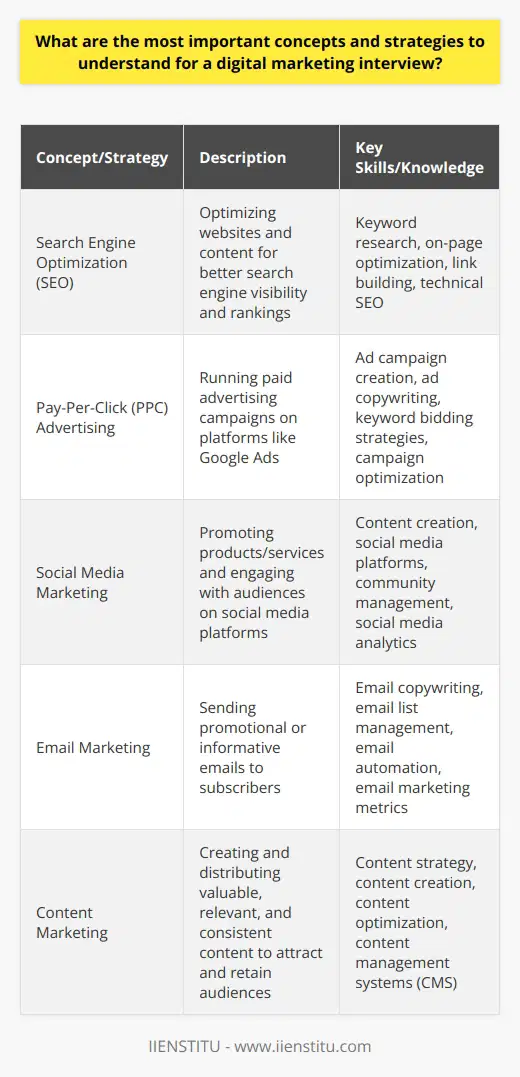
What are the key components of a successful digital marketing strategy?
A successful digital marketing strategy encompasses several critical components that work together to achieve business objectives. These components include a well-defined target audience, clear goals, and a comprehensive approach to reaching and engaging potential customers. Let's explore each of these elements in more detail.
Identifying Your Target Audience
The foundation of any effective digital marketing strategy is a deep understanding of your target audience. This involves conducting thorough market research to identify the demographics, interests, and behaviors of your ideal customers. By crafting detailed buyer personas, you can tailor your marketing efforts to resonate with your audience's needs and preferences.
Conducting Market Research
To gain insights into your target audience, employ various market research techniques such as surveys, focus groups, and data analysis. This research will help you uncover valuable information about your audience's pain points, motivations, and online habits. Use this data to inform your marketing decisions and create targeted campaigns.
Creating Buyer Personas
Based on your market research findings, develop detailed buyer personas that represent your ideal customers. These personas should include demographic information, interests, challenges, and goals. By understanding your target audience on a deeper level, you can craft messaging and content that resonates with them and drives engagement.
Setting Clear Goals and Objectives
A successful digital marketing strategy requires well-defined goals and objectives that align with your overall business objectives. These goals should be specific, measurable, achievable, relevant, and time-bound (SMART). By setting clear targets, you can track your progress and make data-driven decisions to optimize your campaigns.
Defining SMART Goals
When setting goals for your digital marketing strategy, ensure they meet the SMART criteria. For example, instead of a vague goal like "increase website traffic," set a specific goal such as "increase website traffic by 25% within the next quarter." This allows you to measure your success and make adjustments as needed.
Aligning Goals with Business Objectives
Your digital marketing goals should directly contribute to your overall business objectives. Whether your aim is to increase brand awareness, generate leads, or drive sales, ensure that your marketing efforts are designed to support these objectives. Regularly review your goals and adjust your strategy as necessary to stay on track.
Developing a Comprehensive Approach
A successful digital marketing strategy takes a holistic approach, leveraging various channels and tactics to reach and engage your target audience. This includes content marketing, social media marketing, email marketing, search engine optimization (SEO), and paid advertising. By creating a cohesive and integrated strategy, you can maximize your impact and achieve your goals.
Content Marketing
Develop a content marketing plan that includes creating valuable, relevant, and consistent content to attract and retain your target audience. This can include blog posts, videos, infographics, and other formats that educate, entertain, and inspire your audience. By providing high-quality content, you can establish your brand as a trusted authority in your industry.
Social Media Marketing
Leverage social media platforms to connect with your audience, build brand awareness, and drive engagement. Develop a social media strategy that includes regular posting, community management, and paid advertising. By engaging with your followers and creating shareable content, you can expand your reach and foster loyal relationships with your audience.
Email Marketing
Build an email list of subscribers who have opted in to receive communications from your brand. Create targeted email campaigns that deliver value, nurture leads, and drive conversions. Segment your list based on subscriber preferences and behaviors to ensure your messages are relevant and personalized.
Search Engine Optimization (SEO)
Optimize your website and content for search engines to improve your visibility and attract organic traffic. Conduct keyword research to identify relevant terms and phrases that your target audience is searching for. Incorporate these keywords naturally into your content, meta tags, and URLs to improve your search engine rankings.
Paid Advertising

How can businesses effectively measure the ROI of their digital marketing campaigns?
Measuring the return on investment (ROI) of digital marketing campaigns is crucial for businesses to optimize their marketing efforts. To effectively measure ROI, businesses should start by setting clear, measurable goals for each campaign. These goals should align with the overall business objectives and be specific, such as increasing website traffic or generating leads.
Next, businesses must track and analyze key performance indicators (KPIs) relevant to their goals. For example, if the goal is to increase website traffic, businesses should monitor metrics like unique visitors, bounce rate, and time on site. If the goal is to generate leads, businesses should track form submissions, email sign-ups, and conversion rates.
Utilizing Analytics Tools
To gather and analyze this data, businesses should use web analytics tools like Google Analytics. These tools provide valuable insights into user behavior, traffic sources, and conversion paths. By regularly monitoring and interpreting this data, businesses can identify areas of success and opportunities for improvement in their digital marketing campaigns.
Calculating ROI
To calculate the ROI of a digital marketing campaign, businesses should consider both the costs and the revenue generated. Costs may include expenses such as ad spend, content creation, and agency fees. Revenue can be measured by tracking sales, leads, or other monetized actions resulting from the campaign.
The ROI formula is: (Revenue - Costs) / Costs x 100. For example, if a campaign generated $10,000 in revenue and cost $5,000 to execute, the ROI would be: ($10,000 - $5,000) / $5,000 x 100 = 100%.
Attribution Models
To accurately attribute conversions to specific marketing channels, businesses should use attribution models. These models help determine which touchpoints in the customer journey contributed to a conversion. Some common attribution models include first-click, last-click, and multi-touch attribution.
First-Click Attribution
First-click attribution assigns all the credit for a conversion to the first touchpoint in the customer journey. This model is useful for identifying the channels that initially attract customers to a business.
Last-Click Attribution
Last-click attribution assigns all the credit for a conversion to the final touchpoint before the conversion. This model helps businesses identify the channels that directly lead to conversions.
Multi-Touch Attribution
Multi-touch attribution distributes credit for a conversion among all the touchpoints in the customer journey. This model provides a more comprehensive view of how different channels work together to drive conversions.
A/B Testing
To continuously improve the ROI of digital marketing campaigns, businesses should conduct A/B testing. A/B testing involves comparing two versions of a marketing asset, such as an ad or landing page, to determine which performs better. By regularly testing and optimizing marketing assets, businesses can improve conversion rates and maximize ROI.
Conclusion
Measuring the ROI of digital marketing campaigns is essential for businesses to make data-driven decisions and optimize their marketing efforts. By setting clear goals, tracking relevant KPIs, calculating ROI, using attribution models, and conducting A/B testing, businesses can effectively measure and improve the ROI of their digital marketing campaigns.

What are some best practices for optimizing a website for search engines in the context of digital marketing?
To optimize a website for search engines in the context of digital marketing, several best practices can be implemented. These practices aim to improve the website's visibility, ranking, and overall performance in search engine results pages (SERPs). By focusing on key elements such as content, keywords, meta tags, and user experience, digital marketers can enhance their website's search engine optimization (SEO) efforts and attract more organic traffic.
Keyword Research and Optimization
Conducting thorough keyword research is essential for identifying relevant and high-traffic keywords related to the website's content. Digital marketers should use keyword research tools to find keywords with high search volume and low competition. Once identified, these keywords should be strategically incorporated into the website's content, including page titles, headings, meta descriptions, and body text. However, it is crucial to avoid keyword stuffing and maintain a natural flow of content.
High-Quality, Relevant Content
Search engines prioritize websites that offer high-quality, relevant, and engaging content. Digital marketers should focus on creating content that provides value to their target audience. This content should be well-structured, informative, and optimized for the targeted keywords. Regularly updating the website with fresh content, such as blog posts, articles, or product descriptions, can help improve its relevance and authority in the eyes of search engines.
On-Page Optimization
On-page optimization involves optimizing individual web pages to improve their search engine rankings. This includes optimizing page titles, meta descriptions, header tags (H1, H2, etc.), and content. Page titles should be concise, descriptive, and include the primary keyword. Meta descriptions should provide a compelling summary of the page's content and encourage users to click through from the search results. Header tags should be used to structure the content hierarchically and incorporate relevant keywords.
Mobile-Friendliness and Responsive Design
With the increasing use of mobile devices for web browsing, having a mobile-friendly website is crucial for SEO. Digital marketers should ensure that their website is responsive and adapts seamlessly to different screen sizes. This involves using a responsive design framework, optimizing images for faster loading, and ensuring that the website's content is easily readable and navigable on mobile devices. Search engines, such as Google, prioritize mobile-friendly websites in their mobile search results.
Page Speed Optimization
Page speed is a critical factor in SEO and user experience. Slow-loading websites can negatively impact search engine rankings and lead to higher bounce rates. Digital marketers should optimize their website's page speed by compressing images, minimizing HTTP requests, enabling browser caching, and using a content delivery network (CDN). Tools like Google PageSpeed Insights can help identify areas for improvement and provide recommendations to enhance page speed.
Internal Linking Structure
Creating a well-structured internal linking architecture helps search engines understand the hierarchy and relevance of a website's pages. Digital marketers should incorporate internal links within their content, linking to other relevant pages on the website. This helps distribute link equity, improves navigation, and encourages users to explore more content. A clear and logical internal linking structure also makes it easier for search engines to crawl and index the website's pages.
Secure Website (HTTPS)
Security is a top priority for search engines, and websites that use HTTPS (Hypertext Transfer Protocol Secure) are favored in search rankings. Digital marketers should ensure that their website has an SSL (Secure Sockets Layer) certificate installed, which encrypts the data transmitted between the website and its visitors. This helps protect sensitive information, such as login credentials or payment details, and provides a safer browsing experience for users.
By implementing these best practices, digital marketers can optimize their websites for search engines, improve their search rankings, and drive more organic traffic. However, it is essential to keep in mind that SEO is an ongoing process, and staying up-to-date with the latest search engine algorithms and guidelines is crucial for long-term success.

What are the key components of a successful digital marketing strategy?
A successful digital marketing strategy consists of several essential components that work together to achieve business objectives. These components include a well-defined target audience, clear goals and objectives, and a comprehensive plan of action. Additionally, a strong brand identity, engaging content, and effective channels for distribution are crucial to the success of any digital marketing campaign.
Defining Your Target Audience
The first step in creating a successful digital marketing strategy is to identify and understand your target audience. This involves conducting thorough research to determine their demographics, interests, behaviors, and preferences. By clearly defining your target audience, you can tailor your messaging and content to resonate with them effectively.
Setting Clear Goals and Objectives
Establishing clear goals and objectives is essential for measuring the success of your digital marketing efforts. These goals should be specific, measurable, achievable, relevant, and time-bound (SMART). Examples of digital marketing goals include increasing website traffic, generating leads, improving conversion rates, and enhancing brand awareness.
Developing a Comprehensive Plan of Action
Once you have defined your target audience and set clear goals, you need to develop a comprehensive plan of action. This plan should outline the strategies and tactics you will employ to achieve your objectives. It should include a content marketing plan, social media strategy, email marketing campaigns, and paid advertising initiatives.
Building a Strong Brand Identity
A strong brand identity is crucial for establishing trust and credibility with your target audience. This involves creating a consistent visual identity across all digital channels, including your website, social media profiles, and advertising materials. Your brand should communicate your unique value proposition and differentiate you from competitors.
Creating Engaging Content
Content is the backbone of any successful digital marketing strategy. It should be informative, engaging, and valuable to your target audience. Your content should address their pain points, answer their questions, and provide solutions to their problems. Types of content include blog posts, videos, infographics, case studies, and webinars.
Choosing Effective Channels for Distribution
Selecting the right channels for distributing your content is essential for reaching your target audience effectively. This involves understanding where your audience spends their time online and which channels they prefer for consuming content. Common distribution channels include social media platforms, email, websites, and paid advertising.
Measuring and Analyzing Results
Regularly measuring and analyzing the results of your digital marketing efforts is crucial for optimizing your strategy over time. This involves tracking key performance indicators (KPIs) such as website traffic, engagement rates, conversion rates, and revenue generated. By continuously monitoring and adjusting your strategy based on data-driven insights, you can maximize your return on investment (ROI).
Conclusion
A successful digital marketing strategy requires careful planning, execution, and optimization. By defining your target audience, setting clear goals, developing a comprehensive plan of action, building a strong brand identity, creating engaging content, selecting effective distribution channels, and measuring results, you can achieve your business objectives and stay ahead of the competition in the ever-evolving digital landscape.

What are the best practices for optimizing a website for search engine rankings?
To optimize a website for search engine rankings, several best practices should be implemented. First, conduct keyword research to identify relevant and high-traffic keywords. Incorporate these keywords naturally into the website's content, including titles, headings, and meta descriptions. Use descriptive and compelling titles and meta descriptions to attract clicks from search results.
Content Optimization
Create high-quality, original, and informative content that provides value to the target audience. Ensure the content is well-structured, easy to read, and includes relevant keywords. Use subheadings, bullet points, and short paragraphs to improve readability and user engagement. Regularly update the website with fresh content to keep it current and relevant.
On-Page Optimization
Optimize the website's on-page elements, such as header tags (H1, H2, etc.), meta tags, and images. Use descriptive and keyword-rich alt tags for images to improve their visibility in search results. Ensure the website has a clear and logical structure, with a well-organized navigation menu. Use breadcrumbs to help users and search engines understand the website's hierarchy.
Technical Optimization
Improve the website's technical aspects to enhance its search engine friendliness. Ensure fast page load speeds by optimizing images, minimizing code, and leveraging caching techniques. Make the website mobile-friendly and responsive to provide a seamless user experience across devices. Use clean and search engine-friendly URLs that include relevant keywords.
Link Building
Engage in link building strategies to acquire high-quality backlinks from reputable websites. Create valuable and shareable content that naturally attracts links. Reach out to relevant websites and blogs for guest posting opportunities. Participate in industry forums and online communities to build relationships and generate backlinks.
Local SEO
For businesses targeting local customers, optimize the website for local search. Claim and optimize the Google My Business listing, including accurate business information and customer reviews. Include local keywords in the website's content and meta tags. Build local citations by listing the business in relevant online directories and local listings.
Analytics and Monitoring
Regularly monitor the website's search engine rankings and traffic using tools like Google Analytics. Analyze the data to identify areas for improvement and track the effectiveness of optimization efforts. Monitor backlinks and ensure they come from reputable sources. Stay updated with the latest SEO trends and algorithm updates to adapt the optimization strategy accordingly.
User Experience
Prioritize user experience by creating a user-friendly and intuitive website design. Ensure easy navigation, fast loading times, and clear calls-to-action. Provide valuable and engaging content that keeps visitors on the website longer. Encourage user interaction through comments, social sharing, and other interactive elements.
By following these best practices consistently and staying updated with SEO trends, a website can improve its search engine rankings and attract more organic traffic. Remember, SEO is an ongoing process that requires continuous effort and adaptation to achieve long-term success.
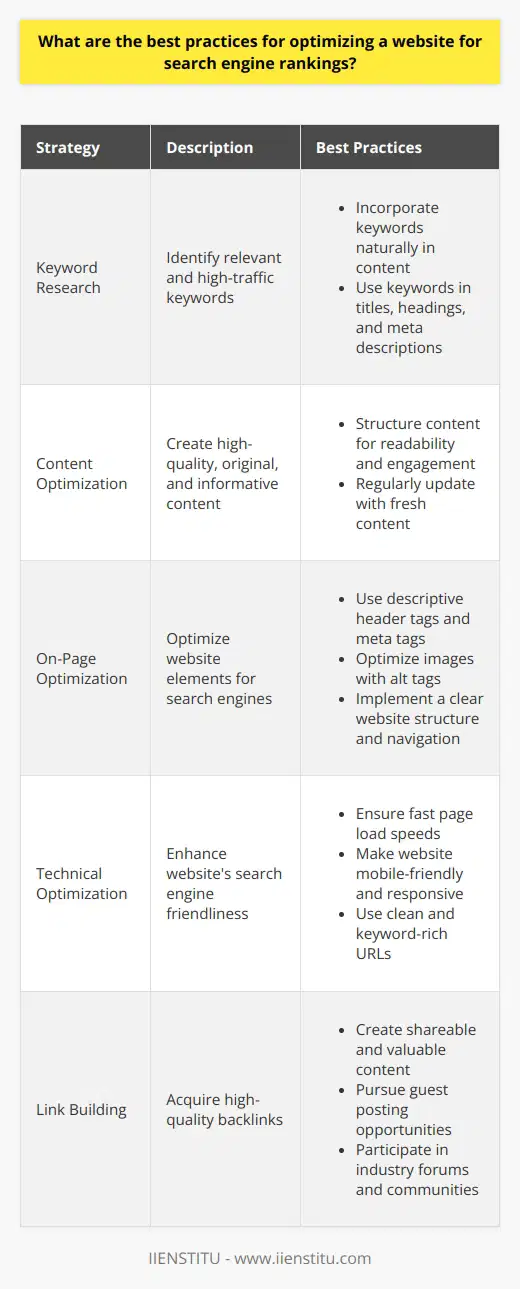
Why do you want to pursue a career in digital marketing?
Pursuing a career in digital marketing is an attractive prospect for several compelling reasons. Firstly, the field of digital marketing is experiencing rapid growth and is expected to continue expanding in the coming years. As more businesses recognize the importance of establishing a strong online presence, the demand for skilled digital marketers will inevitably rise. This growth potential offers job security and numerous opportunities for career advancement.
The Dynamic Nature of Digital Marketing
Another appealing aspect of digital marketing is its dynamic and ever-evolving nature. The digital landscape is constantly changing, with new technologies, platforms, and trends emerging regularly. This fast-paced environment keeps digital marketers on their toes, requiring them to continuously learn and adapt to stay ahead of the curve. For individuals who thrive on challenges and enjoy staying up-to-date with the latest developments, digital marketing provides an exciting and stimulating career path.
Creativity and Innovation
Digital marketing also allows for a high degree of creativity and innovation. Unlike traditional marketing methods, digital marketing offers a wide range of channels and tactics to reach and engage target audiences. From social media campaigns and content creation to email marketing and search engine optimization, digital marketers have the opportunity to develop innovative strategies and experiment with new approaches. This creative freedom enables marketers to express their ideas, think outside the box, and make a tangible impact on a brand's success.
Data-Driven Decision Making
Moreover, digital marketing is highly data-driven, which appeals to individuals who enjoy working with numbers and analytics. Digital marketers have access to a wealth of data that allows them to track the effectiveness of their campaigns, measure key performance indicators, and make informed decisions based on real-time insights. The ability to analyze data, identify patterns, and optimize strategies accordingly is a valuable skill in today's business world, making digital marketers highly sought-after professionals.
Versatility and Flexibility
Digital marketing also offers versatility and flexibility in terms of career paths. Within the broad field of digital marketing, there are various specializations to choose from, such as content marketing, social media marketing, email marketing, and search engine optimization. This diversity allows individuals to focus on areas that align with their interests and strengths, while also providing opportunities to broaden their skill set over time. Additionally, many digital marketing roles offer the possibility of remote work, enabling professionals to enjoy a better work-life balance and work from anywhere with an internet connection.
Making a Positive Impact
Finally, pursuing a career in digital marketing allows individuals to make a positive impact on businesses and society as a whole. By helping companies effectively reach and engage their target audiences, digital marketers contribute to the growth and success of businesses across various industries. They play a crucial role in shaping brand perception, driving customer loyalty, and ultimately influencing consumer behavior. This ability to directly impact a company's bottom line and make a tangible difference is highly rewarding and fulfilling.
Conclusion
In conclusion, a career in digital marketing offers a multitude of benefits, including growth potential, a dynamic work environment, creative freedom, data-driven decision making, versatility, and the opportunity to make a positive impact. As the digital landscape continues to evolve, the demand for skilled digital marketers will only continue to rise, making it an exciting and promising field to pursue.

What aspects of digital marketing do you find most appealing and why?
Digital marketing offers a multitude of appealing aspects that make it an exciting and dynamic field. One of the most attractive features is the ability to reach a vast audience with targeted precision. By leveraging data analytics and user behavior insights, digital marketers can craft personalized messages that resonate with specific segments of their target market. This level of customization greatly enhances the effectiveness of marketing campaigns and allows businesses to build stronger connections with their customers.
The Power of Measurable Results
Another highly appealing aspect of digital marketing is the ease of measuring and tracking results. Unlike traditional marketing methods, digital platforms provide a wealth of data that can be analyzed to determine the success of campaigns in real-time. Marketers can monitor metrics such as click-through rates, conversion rates, and engagement levels to gain valuable insights into the performance of their efforts. This data-driven approach enables continuous optimization and refinement of marketing strategies, ensuring that resources are allocated effectively and ROI is maximized.
Engaging Interactive Experiences
Digital marketing also opens up opportunities for creating engaging and interactive experiences for consumers. Through the use of interactive content such as quizzes, polls, and gamified elements, brands can foster active participation and build deeper connections with their audience. This level of engagement not only captures attention but also encourages users to spend more time interacting with the brand, leading to increased brand awareness and loyalty. Interactive experiences also provide valuable data points that can be used to further refine marketing strategies and improve overall customer experiences.
Cost-Effective and Agile
Compared to traditional marketing channels, digital marketing offers a more cost-effective and agile approach. With the ability to target specific audiences and adjust campaigns in real-time, businesses can optimize their marketing spend and achieve better results with smaller budgets. Digital marketing also allows for quick iterations and experimentation, enabling marketers to test different strategies and adapt to changing market conditions rapidly. This agility is particularly valuable in today's fast-paced business environment, where the ability to pivot and respond to new opportunities can be a key differentiator.
Cultivating Authentic Relationships
Digital marketing provides a platform for brands to cultivate authentic relationships with their customers. Through social media engagement, email marketing, and personalized content, businesses can establish a genuine connection with their audience. By listening to customer feedback, addressing concerns, and providing valuable information, brands can build trust and loyalty over time. This authentic approach to marketing fosters a sense of community and encourages long-term customer retention, ultimately contributing to the success and growth of the business.
In conclusion, the appealing aspects of digital marketing lie in its ability to deliver targeted, measurable, and engaging experiences while being cost-effective and agile. By leveraging the power of data, interactivity, and authentic relationships, digital marketers can create campaigns that resonate with their audience and drive meaningful results for their businesses. As the digital landscape continues to evolve, the opportunities for innovation and growth in digital marketing are boundless, making it an exciting and rewarding field to be a part of.

How do you think your skills and experiences align with the requirements of a digital marketing role?
My skills and experiences align well with the requirements of a digital marketing role. I have a strong foundation in various aspects of digital marketing, including content creation, social media management, and data analysis. Throughout my career, I have developed and implemented successful marketing strategies that have helped businesses grow their online presence and engage with their target audience effectively.
Content Creation and Copywriting
I possess excellent copywriting skills, which enable me to create compelling and engaging content for various digital platforms. I have experience in writing blog posts, product descriptions, email newsletters, and social media posts. I understand the importance of crafting content that resonates with the target audience and drives them to take action.
SEO and SEM
I have a solid understanding of search engine optimization (SEO) and search engine marketing (SEM) principles. I can optimize website content and structure to improve search engine rankings and drive organic traffic. Additionally, I have experience in running successful pay-per-click (PPC) campaigns on platforms like Google Ads and Bing Ads.
Social Media Marketing
I am well-versed in social media marketing and have managed social media accounts for various brands. I know how to create engaging content, interact with followers, and analyze social media metrics to measure the success of campaigns. I stay up-to-date with the latest trends and best practices in social media marketing to ensure maximum effectiveness.
Email Marketing
I have experience in developing and executing email marketing campaigns. I can create targeted email lists, design visually appealing email templates, and write compelling email copy. I understand the importance of segmentation, personalization, and A/B testing to optimize email marketing efforts and improve conversion rates.
Data Analysis and Reporting
I am proficient in using analytics tools like Google Analytics to track and analyze website traffic, user behavior, and conversion rates. I can interpret data and provide meaningful insights to make data-driven decisions. I have experience in creating comprehensive reports that showcase the performance of digital marketing campaigns and provide recommendations for improvement.
Collaboration and Communication
I am a strong collaborator and communicator. I work well in a team environment and can effectively communicate with colleagues, clients, and stakeholders. I understand the importance of aligning digital marketing efforts with overall business objectives and can clearly articulate strategies and results to both technical and non-technical audiences.
Continuous Learning and Adaptability
Digital marketing is a constantly evolving field, and I am committed to continuous learning and staying updated with the latest industry trends and best practices. I am adaptable and can quickly learn new tools and technologies to enhance my digital marketing skills and deliver better results.
In conclusion, my skills and experiences in content creation, SEO, SEM, social media marketing, email marketing, data analysis, collaboration, and continuous learning make me a strong candidate for a digital marketing role. I am confident in my ability to contribute to the success of a company's digital marketing efforts and drive meaningful results.
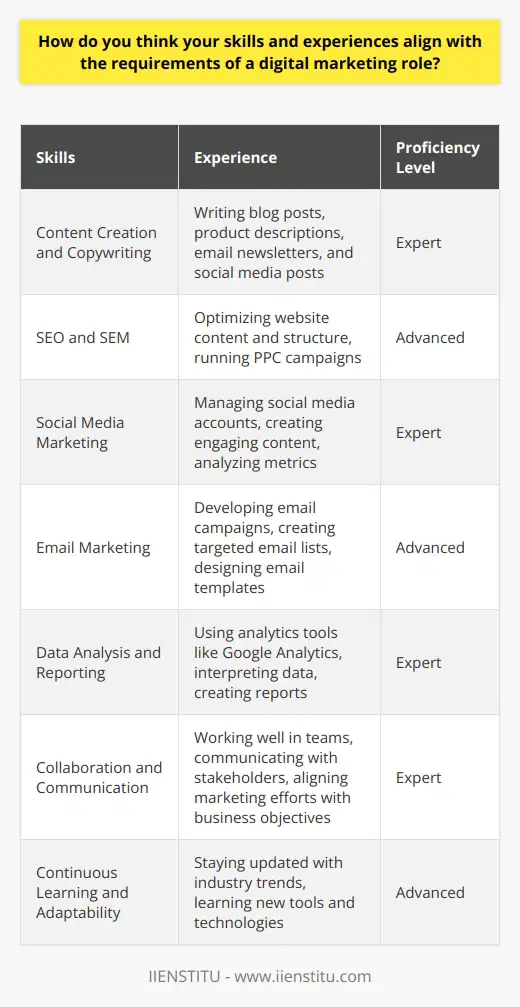
What motivated you to pursue a career in digital marketing?
Digital marketing has become an increasingly attractive career path for many individuals in recent years. The motivation to pursue a career in this field can stem from various factors, including a passion for technology, a desire to engage with consumers in innovative ways, and the potential for professional growth and development.
Passion for Technology and Innovation
One of the primary motivators for individuals seeking a career in digital marketing is a genuine passion for technology and innovation. The digital landscape is constantly evolving, with new platforms, tools, and strategies emerging regularly. Those who are excited by the prospect of staying at the forefront of technological advancements and applying them to marketing initiatives are naturally drawn to this field.
Engaging with Consumers in Creative Ways
Digital marketing provides a unique opportunity to connect with consumers in creative and meaningful ways. Through various digital channels, marketers can reach target audiences, build brand awareness, and foster engagement. The ability to craft compelling content, design interactive experiences, and leverage data-driven insights to better understand consumer behavior is highly appealing to those who enjoy the challenge of creating impactful marketing campaigns.
Professional Growth and Development
The digital marketing industry offers significant potential for professional growth and development. As businesses increasingly recognize the importance of digital marketing in their overall strategy, the demand for skilled professionals in this field continues to rise. This presents opportunities for career advancement, skill acquisition, and exposure to a wide range of industries and projects.
Diverse Range of Specializations
Digital marketing encompasses a diverse range of specializations, allowing individuals to focus on areas that align with their interests and strengths. From search engine optimization (SEO) and pay-per-click (PPC) advertising to content marketing, social media management, and email marketing, there are numerous paths to explore within the digital marketing realm. This diversity enables professionals to find their niche and develop expertise in specific areas of digital marketing.
Measurable Impact and Results
Another motivating factor for pursuing a career in digital marketing is the ability to measure the impact and results of marketing efforts. Digital marketing provides a wealth of data and analytics that allow marketers to track the performance of campaigns, optimize strategies, and demonstrate tangible results to clients or stakeholders. The satisfaction of seeing measurable outcomes and the opportunity to continually refine and improve marketing initiatives is highly rewarding for many professionals in this field.
Flexibility and Work-Life Balance
The digital nature of the work in digital marketing often allows for greater flexibility and work-life balance compared to traditional marketing roles. Many digital marketing professionals have the option to work remotely, set their own schedules, or collaborate with teams across different time zones. This flexibility is particularly appealing to those who value the ability to maintain a healthy work-life balance while still pursuing a challenging and rewarding career.
In conclusion, the motivation to pursue a career in digital marketing stems from a combination of factors, including a passion for technology and innovation, the desire to engage with consumers creatively, and the potential for professional growth and development. With its diverse range of specializations, measurable impact, and the flexibility it offers, digital marketing presents an exciting and fulfilling career path for those who are driven by the ever-evolving digital landscape.
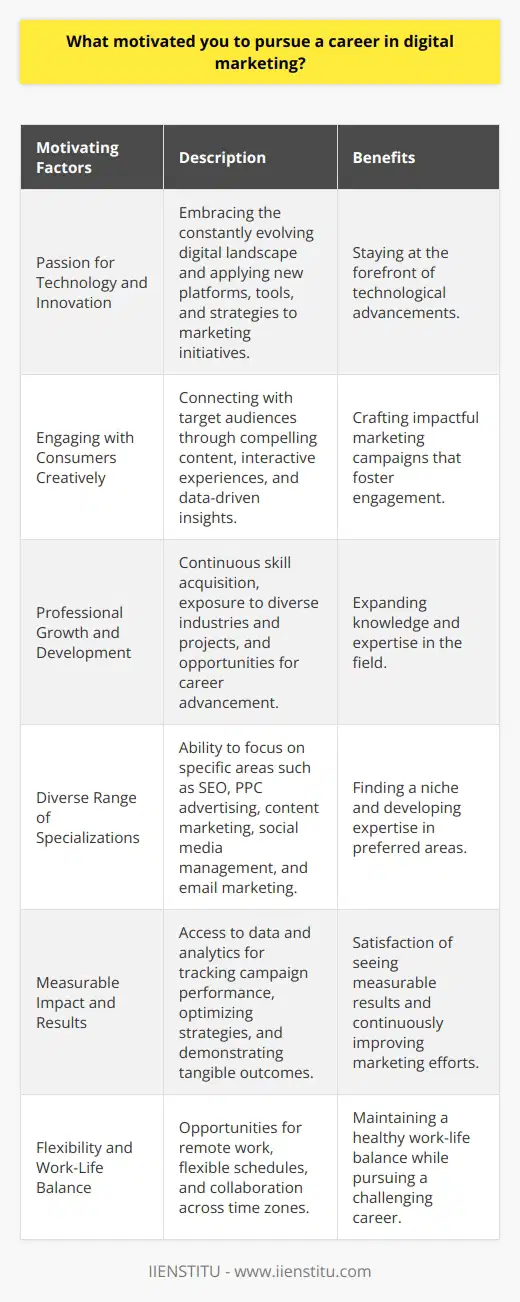
How do you stay up-to-date with the latest trends and best practices in digital marketing?
Staying up-to-date with the latest trends and best practices in digital marketing is crucial for success. One effective method is to regularly read industry blogs and publications. These resources provide valuable insights into emerging technologies, strategies, and case studies. Attending conferences and webinars is another excellent way to learn from experts and network with peers. Social media platforms, such as LinkedIn and Twitter, are also useful for following influencers and joining relevant discussions. Additionally, experimenting with new tools and techniques allows marketers to gain firsthand experience and stay ahead of the curve.
Continuous Learning
Digital marketing is a constantly evolving field, and continuous learning is essential for staying relevant. Setting aside dedicated time for professional development, such as taking online courses or pursuing certifications, can help expand knowledge and skills. Many reputable organizations, like HubSpot and Google, offer free or affordable training programs. Joining professional associations and participating in local meetups can also provide access to valuable resources and networking opportunities. By actively seeking out learning experiences, marketers can adapt to changes and maintain a competitive edge.
Analyzing Competitors
Analyzing competitors' strategies and tactics can provide valuable insights into industry trends and best practices. Regularly monitoring their websites, social media presence, and marketing campaigns can reveal what works and what doesn't. Tools like SEMrush and Ahrefs can help identify competitors' top-performing content and keywords. By understanding competitors' strengths and weaknesses, marketers can adapt their own strategies and find opportunities for differentiation.
Testing and Iteration
Testing and iteration are critical for staying up-to-date with best practices in digital marketing. Experimenting with new ad formats, landing pages, or email templates can help identify what resonates with target audiences. A/B testing allows marketers to compare the performance of different versions and make data-driven decisions. By continuously testing and refining their approaches, marketers can optimize their campaigns and stay ahead of the curve.
Collaborating with Others
Collaborating with colleagues, clients, and partners can provide fresh perspectives and insights into industry trends. Sharing knowledge and experiences can help identify new opportunities and solutions. Participating in cross-functional projects can also expose marketers to different aspects of the business and broaden their understanding of the industry. By fostering a culture of collaboration and open communication, organizations can stay up-to-date with the latest trends and best practices in digital marketing.
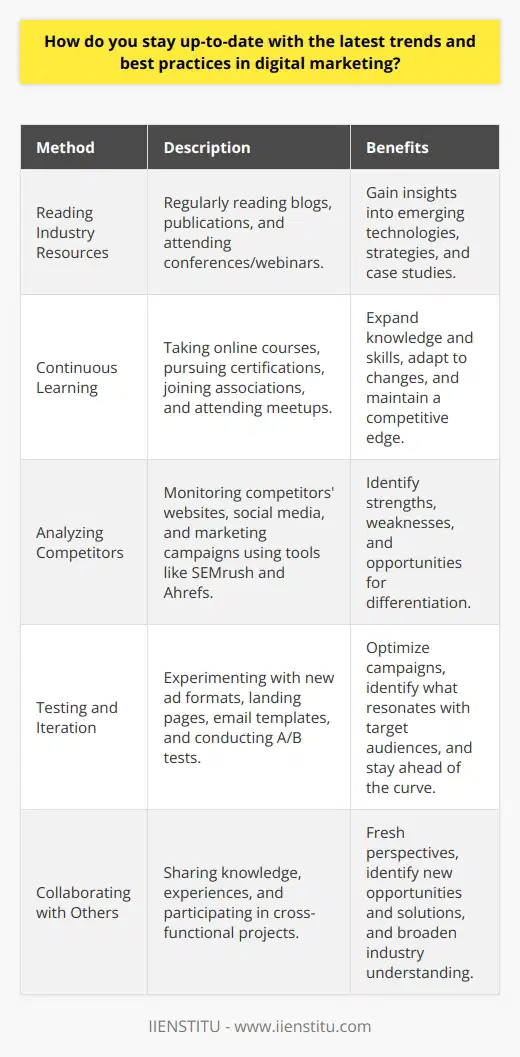
Can you describe a successful digital marketing campaign you have worked on and the key strategies you employed?
One successful digital marketing campaign I worked on involved promoting a new mobile app for a fitness company. The primary objective was to increase app downloads and user engagement. To achieve this, we employed several key strategies that proved to be highly effective.
Targeted Social Media Advertising
We began by conducting thorough market research to identify our target audience's demographics, interests, and online behaviors. Using this information, we created targeted ads on social media platforms such as Facebook, Instagram, and Twitter. We segmented our audience based on age, location, and interests in fitness and health. This allowed us to deliver highly relevant ads to potential users who were most likely to download and engage with the app.
Influencer Marketing
To further increase visibility and credibility, we partnered with popular fitness influencers on social media. These influencers had a strong following within our target audience and were known for their expertise in the fitness industry. We collaborated with them to create sponsored posts, stories, and videos showcasing the app's features and benefits. This approach helped us tap into the influencers' engaged audiences and drive more downloads.
Content Marketing
In addition to advertising, we focused on creating valuable and informative content related to fitness and health. We published blog posts, articles, and videos that provided tips, workouts, and inspiration to our target audience. This content was optimized for search engines to improve organic visibility and attract potential users who were actively seeking fitness-related information online. By establishing ourselves as a trusted resource in the fitness industry, we were able to build brand awareness and encourage app downloads.
App Store Optimization (ASO)
To ensure that our app was easily discoverable in the app stores, we implemented app store optimization techniques. We conducted keyword research to identify the most relevant and high-traffic keywords related to our app's functionality. We then optimized our app's title, description, and metadata to include these keywords strategically. Additionally, we designed eye-catching app icons and screenshots to showcase the app's user interface and key features. These ASO efforts helped improve our app's visibility and ranking in the app store search results.
Referral Program and Incentives
To encourage existing users to spread the word about our app, we implemented a referral program. Users who referred their friends and family to download the app received exclusive rewards, such as premium features or discounts on fitness products. This strategy not only helped us acquire new users through word-of-mouth marketing but also increased user retention and engagement as users felt valued and motivated to continue using the app.
Results and Key Metrics
The combination of targeted advertising, influencer partnerships, content marketing, ASO, and referral programs yielded impressive results. Within the first three months of the campaign, we achieved a 150% increase in app downloads compared to the previous quarter. The app's user engagement metrics, such as daily active users and average session duration, also saw significant improvements. The campaign successfully raised brand awareness, attracted a large number of new users, and established the app as a top choice in the competitive fitness app market.
By employing a multi-faceted approach and consistently monitoring and optimizing our strategies, we were able to create a successful digital marketing campaign that delivered tangible results for the fitness company. The key to success was understanding our target audience, leveraging the right channels and partnerships, and providing value through engaging content and incentives.
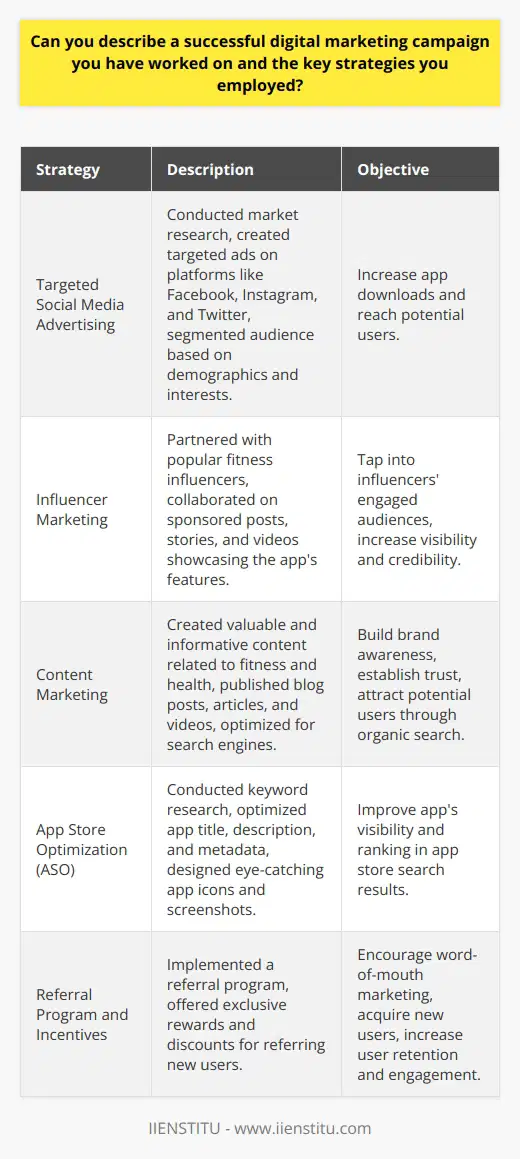
What are some common challenges faced in digital marketing, and how can they be overcome?
Digital marketing presents various challenges that businesses must navigate to achieve success in the online landscape. One significant challenge is the constantly evolving nature of digital platforms and technologies. Marketing strategies that work today may become obsolete tomorrow, requiring businesses to adapt quickly. To overcome this, companies should stay informed about the latest trends, tools, and best practices in digital marketing. Regularly attending industry conferences, workshops, and webinars can help marketers stay up-to-date and make informed decisions.
Attracting and Retaining Customers
Another common challenge is attracting and retaining customers in a highly competitive digital environment. With countless businesses vying for attention online, it can be difficult to stand out and build a loyal customer base. To address this, companies should focus on creating valuable, relevant, and engaging content that resonates with their target audience. By understanding the needs, preferences, and pain points of their customers, businesses can develop targeted marketing campaigns that effectively capture attention and drive conversions.
Measuring and Analyzing Performance
Measuring and analyzing the performance of digital marketing efforts is also a significant challenge. With a plethora of metrics and data points available, it can be overwhelming to determine which ones truly matter. To overcome this, businesses should establish clear goals and key performance indicators (KPIs) that align with their overall objectives. By focusing on the most relevant metrics and regularly monitoring and analyzing data, marketers can gain valuable insights into what's working and what needs improvement, allowing them to optimize their strategies accordingly.
Ensuring Data Privacy and Security
Data privacy and security concerns pose another challenge in digital marketing. With increasing regulations and consumer awareness around data protection, businesses must prioritize the responsible handling of customer information. To address this, companies should implement robust data security measures, such as encryption and secure storage protocols. They should also be transparent about their data collection and usage practices, providing clear privacy policies and giving customers control over their data. By demonstrating a commitment to data privacy and security, businesses can build trust with their audience and mitigate potential risks.
Adapting to Mobile-First Environments
The rise of mobile devices has created a new challenge for digital marketers: adapting to mobile-first environments. With more people accessing the internet through smartphones and tablets, businesses must ensure that their websites, content, and campaigns are optimized for mobile viewing. This involves responsive design, fast load times, and user-friendly navigation. By prioritizing mobile optimization, companies can improve the user experience, increase engagement, and drive better results from their mobile marketing efforts.
Staying Ahead of the Competition
Staying ahead of the competition is an ongoing challenge in digital marketing. With new businesses entering the online space every day, it's crucial to differentiate oneself and offer unique value to customers. To achieve this, companies should continuously monitor their competitors, analyze their strategies, and identify opportunities for innovation. By leveraging emerging technologies, exploring new channels, and developing creative campaigns, businesses can stay ahead of the curve and maintain a competitive edge in the digital landscape.

How do you measure the success of a digital marketing campaign, and what metrics do you consider most important?
Measuring the success of a digital marketing campaign involves tracking and analyzing various metrics. These metrics provide valuable insights into the effectiveness of the campaign and help identify areas for improvement. The most important metrics to consider when evaluating a digital marketing campaign's success include:
Website Traffic
Website traffic is a crucial metric to monitor. It indicates the number of visitors your website receives. An increase in website traffic suggests that your marketing efforts are attracting more people to your site. Tools like Google Analytics can help track website traffic and provide detailed insights into visitor behavior.
Conversion Rate
Conversion rate measures the percentage of website visitors who take a desired action. This action could be making a purchase, filling out a form, or subscribing to a newsletter. A high conversion rate indicates that your marketing campaign is effectively persuading visitors to engage with your brand. Optimizing your website's user experience and creating compelling calls-to-action can improve conversion rates.
Engagement Metrics
Engagement metrics include factors such as bounce rate, time spent on site, and pages per session. These metrics provide insights into how visitors interact with your website. A low bounce rate and high time spent on site suggest that visitors find your content relevant and engaging. Improving the quality and relevance of your content can enhance engagement metrics.
Social Media Metrics
Social media metrics measure the impact of your marketing efforts on social media platforms. These metrics include followers, likes, shares, comments, and click-through rates. A growing social media following and high engagement rates indicate that your content resonates with your target audience. Consistently creating valuable and shareable content can boost social media metrics.
Return on Investment (ROI)
ROI measures the financial return generated from your marketing investment. It helps determine whether your campaign is profitable. To calculate ROI, divide the net profit by the total marketing expenditure and multiply by 100. A positive ROI indicates that your campaign is generating more revenue than it costs. Regularly monitoring and optimizing your campaigns can improve ROI.
Customer Lifetime Value (CLV)
CLV represents the total amount of money a customer is expected to spend on your products or services throughout their relationship with your brand. Increasing CLV through targeted marketing efforts and exceptional customer service can lead to long-term profitability. Strategies like personalized recommendations and loyalty programs can help maximize CLV.
Brand Awareness
Brand awareness measures how familiar your target audience is with your brand. Increased brand awareness can lead to higher trust, loyalty, and sales. Metrics like search volume, social media mentions, and survey responses can help gauge brand awareness. Consistently delivering valuable content and engaging with your audience can enhance brand awareness.
To measure the success of a digital marketing campaign effectively, it's essential to set clear goals and track relevant metrics. By regularly monitoring and analyzing these metrics, you can make data-driven decisions to optimize your campaigns and achieve better results. Remember, the most important metrics may vary depending on your specific marketing objectives and target audience.
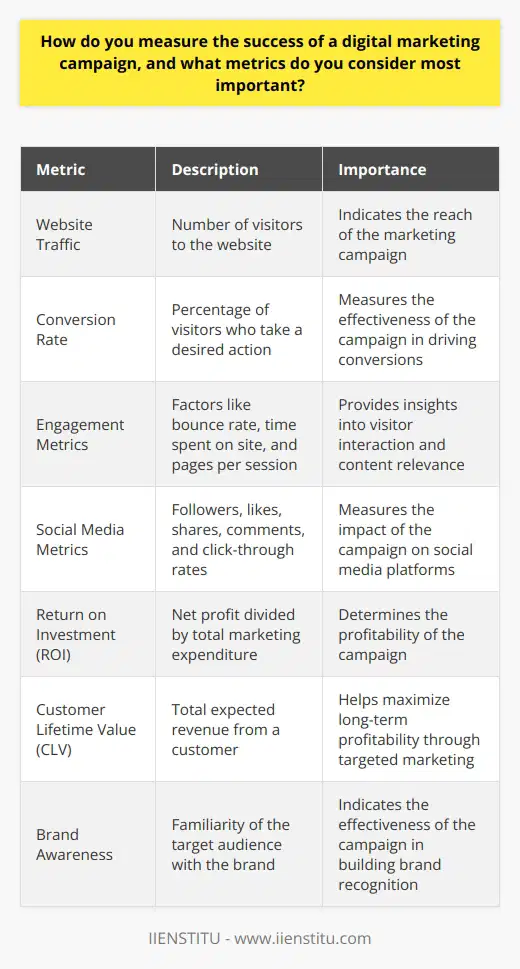
Can you discuss a recent digital marketing trend or innovation that has caught your attention, and how it might impact the industry?
One recent digital marketing trend that has captured my attention is the rise of conversational AI chatbots. These intelligent virtual assistants are revolutionizing the way brands interact with their customers online. By leveraging natural language processing and machine learning, chatbots can engage in human-like conversations, answer queries, and provide personalized recommendations in real-time.
Enhancing Customer Experience
Conversational AI chatbots have the potential to significantly enhance the customer experience. They are available 24/7, providing instant support and guidance whenever customers need it. This immediacy and accessibility can lead to increased customer satisfaction and loyalty. Chatbots can handle routine inquiries, freeing up human customer service representatives to focus on more complex issues that require a personal touch.
Personalization at Scale
Another key benefit of conversational AI chatbots is their ability to deliver personalization at scale. By analyzing customer data and preferences, chatbots can tailor their responses and recommendations to each individual user. This level of personalization can foster stronger connections between brands and customers, leading to increased engagement and conversions.
Streamlining Marketing Efforts
Conversational AI chatbots can also streamline digital marketing efforts. They can be integrated into various channels, such as websites, social media platforms, and messaging apps. This integration allows brands to reach customers where they already are, providing a seamless and convenient experience. Chatbots can assist with lead generation, product recommendations, and even sales, making them a valuable tool in the digital marketer's arsenal.
Data-Driven Insights
Moreover, conversational AI chatbots generate valuable data and insights. Every interaction with a chatbot provides marketers with information about customer preferences, pain points, and behavior. This data can be analyzed to identify patterns, improve marketing strategies, and optimize the overall customer experience. By leveraging these insights, brands can make data-driven decisions and stay ahead of the curve in the ever-evolving digital landscape.
Challenges and Considerations
While conversational AI chatbots offer numerous benefits, there are also challenges and considerations to keep in mind. Ensuring the accuracy and relevance of chatbot responses is crucial to maintain user trust. Brands must invest in robust natural language processing and machine learning algorithms to enable chatbots to understand and respond appropriately to user queries. Additionally, integrating chatbots seamlessly into existing marketing strategies and customer support systems requires careful planning and execution.
Conclusion
The rise of conversational AI chatbots is a significant digital marketing trend that has the potential to reshape the industry. By enhancing customer experience, delivering personalization at scale, streamlining marketing efforts, and providing data-driven insights, chatbots are becoming an indispensable tool for brands. As the technology continues to evolve, it will be exciting to see how conversational AI transforms the way businesses engage with their customers in the digital realm.

What are the key skills and qualities required for a successful digital marketing manager?
A successful digital marketing manager must possess a diverse set of skills and qualities to excel in their role. They should have a strong understanding of various digital marketing channels, such as social media, email marketing, search engine optimization (SEO), and pay-per-click (PPC) advertising. The ability to analyze data and derive actionable insights is crucial for making informed decisions and optimizing campaigns.
Communication and Leadership Skills
Effective communication is essential for a digital marketing manager. They must be able to clearly convey strategies and goals to their team and stakeholders. Strong leadership skills are necessary to guide and motivate team members, fostering a collaborative and productive work environment.
Adaptability and Continuous Learning
The digital landscape is constantly evolving, with new technologies and platforms emerging regularly. A successful digital marketing manager must be adaptable and willing to embrace change. They should have a curious mindset and be committed to continuous learning to stay updated with industry trends and best practices.
Strategic Thinking and Problem-Solving
Digital marketing managers must be strategic thinkers, able to develop and execute comprehensive marketing plans. They should have the ability to identify opportunities, anticipate challenges, and devise creative solutions. Problem-solving skills are essential for navigating complex situations and overcoming obstacles that may arise during campaign implementation.
Data Analysis and Reporting
Proficiency in data analysis is crucial for a digital marketing manager. They should be comfortable working with various analytics tools to track and measure campaign performance. The ability to interpret data, identify patterns, and generate meaningful reports is essential for making data-driven decisions and demonstrating the ROI of marketing efforts.
Project Management and Organizational Skills
Digital marketing managers often juggle multiple projects and deadlines simultaneously. Strong project management skills are necessary to ensure smooth execution and timely delivery. They should be highly organized, able to prioritize tasks, and effectively allocate resources to achieve desired outcomes.
Creativity and Innovation
In the competitive digital landscape, creativity and innovation are key differentiators. A successful digital marketing manager should have a creative mindset, always seeking new and innovative ways to engage audiences and stand out from competitors. They should be open to experimenting with new strategies and tactics to drive better results.
Customer-Centric Approach
A customer-centric approach is essential for effective digital marketing. Managers should have a deep understanding of their target audience, their needs, preferences, and behaviors. They should be able to develop customer personas and tailor marketing messages and strategies to resonate with specific segments.
Collaboration and Teamwork
Digital marketing managers rarely work in isolation. They collaborate with various teams, including content creators, designers, developers, and sales. Strong collaboration and teamwork skills are crucial for ensuring seamless integration of marketing efforts and achieving common goals.
In summary, a successful digital marketing manager must possess a combination of technical expertise, strategic thinking, leadership, and communication skills. They should be data-driven, creative, adaptable, and customer-centric in their approach. By continuously learning and staying updated with industry trends, they can effectively navigate the ever-evolving digital landscape and drive successful marketing campaigns.
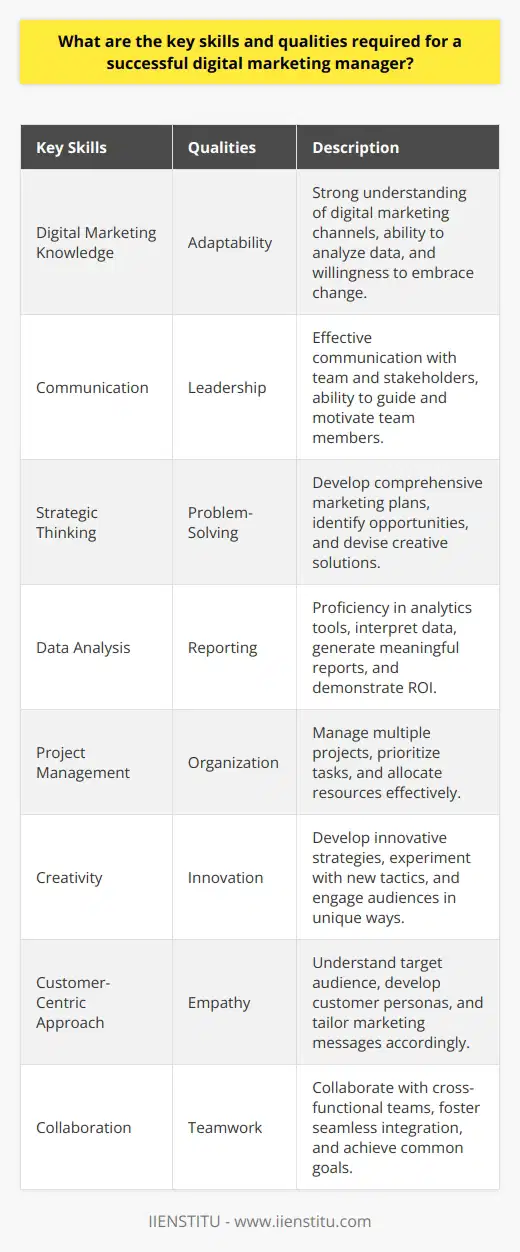
How do you stay up-to-date with the latest digital marketing trends and technologies?
Staying up-to-date with the latest digital marketing trends and technologies is crucial for marketers to remain competitive. One effective way to stay informed is by regularly reading industry blogs and publications. These resources provide valuable insights into emerging trends, best practices, and case studies. Additionally, attending digital marketing conferences and webinars can expose marketers to new ideas and strategies. Networking with other professionals in the field can also lead to valuable knowledge sharing and collaboration opportunities.
Leverage Social Media
Social media platforms are excellent sources for staying current with digital marketing trends. Following influential thought leaders and industry experts on Twitter, LinkedIn, and other platforms can provide a steady stream of relevant information. Joining online communities and groups dedicated to digital marketing can also facilitate discussions and knowledge exchange with peers. Furthermore, subscribing to email newsletters from reputable marketing organizations can deliver timely updates directly to your inbox.
Experiment and Analyze
Hands-on experience is invaluable for staying up-to-date with digital marketing technologies. Experimenting with new tools and platforms allows marketers to gain practical knowledge and assess their potential impact. Conducting small-scale tests and analyzing the results can provide valuable insights into the effectiveness of different strategies. By actively engaging with new technologies, marketers can develop a deeper understanding of their capabilities and limitations.
Invest in Continuous Learning
Continuous learning is essential for staying ahead in the ever-evolving digital marketing landscape. Enrolling in online courses and certification programs can provide structured learning opportunities. Platforms like Coursera, Udemy, and HubSpot Academy offer a wide range of digital marketing courses taught by industry experts. These courses cover topics such as search engine optimization (SEO), pay-per-click (PPC) advertising, content marketing, and social media marketing. Investing time and resources in self-education demonstrates a commitment to professional growth and adaptability.
Monitor Industry Reports and Research
Keeping an eye on industry reports and research studies can provide valuable insights into digital marketing trends. Reputable research firms like Gartner, Forrester, and eMarketer regularly publish reports on various aspects of digital marketing. These reports often include data-driven insights, market forecasts, and expert opinions. By reviewing these reports, marketers can gain a broader perspective on industry developments and make informed strategic decisions.
Engage with Your Network
Engaging with your professional network is another effective way to stay up-to-date. Participating in online forums, LinkedIn groups, and industry-specific social media communities allows you to connect with peers, share knowledge, and learn from their experiences. Attending local meetups and networking events can also provide opportunities to discuss the latest trends and technologies with like-minded professionals. Building relationships within your network can lead to valuable insights and collaborations.
Embrace a Growth Mindset
Staying up-to-date with digital marketing trends and technologies requires a growth mindset. Embrace change and be open to new ideas and approaches. Continuously challenge yourself to learn and adapt to the evolving landscape. By cultivating a curious and proactive attitude, you can position yourself to stay ahead of the curve and excel in your digital marketing career.
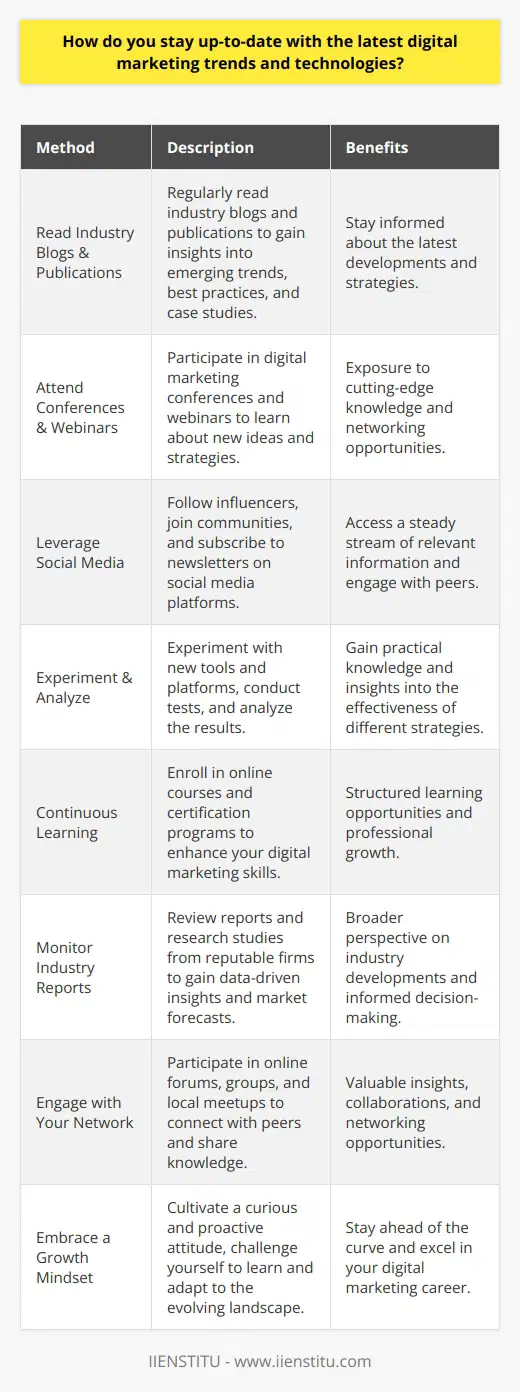
Can you describe a challenging digital marketing campaign you have managed and how you overcame any obstacles?
Managing a challenging digital marketing campaign requires a strategic approach, adaptability, and effective problem-solving skills. One particularly demanding campaign I handled involved promoting a new product launch for a tech startup. The primary obstacle was the highly competitive market and the limited brand recognition of the company.
Conducting Thorough Market Research
To overcome this challenge, I began by conducting extensive market research to identify the target audience and their preferences. This involved analyzing competitor strategies, consumer behavior, and industry trends. By gathering valuable insights, I could develop a tailored marketing plan that resonated with the intended audience.
Developing a Unique Value Proposition
Next, I focused on crafting a unique value proposition that highlighted the product's distinctive features and benefits. This required close collaboration with the product development team to ensure the messaging accurately reflected the product's capabilities. I also worked on creating compelling content that effectively communicated the value proposition to potential customers.
Implementing a Multi-Channel Strategy
To maximize the campaign's reach and impact, I implemented a multi-channel strategy that leveraged various digital platforms. This included social media marketing, targeted email campaigns, influencer partnerships, and paid advertising. By diversifying the marketing channels, I could engage with the target audience across multiple touchpoints and increase brand visibility.
Optimizing Campaign Performance
Throughout the campaign, I closely monitored key performance indicators and conducted regular data analysis. This allowed me to identify areas of improvement and make data-driven decisions to optimize the campaign's effectiveness. I continuously refined targeting, ad creatives, and landing pages to enhance user engagement and conversion rates.
Adapting to Challenges
One significant challenge I encountered was a sudden algorithm change on a major social media platform. This affected the organic reach and engagement of our posts. To mitigate this issue, I quickly adjusted the content strategy, focusing on creating highly shareable and interactive content that encouraged user participation. Additionally, I allocated more resources to paid advertising to maintain the campaign's visibility.
Achieving Successful Results
Through continuous optimization and adaptation, the digital marketing campaign achieved substantial results. The product launch generated significant buzz, attracting a large number of early adopters. The campaign also contributed to a notable increase in website traffic, lead generation, and overall brand awareness. By successfully navigating the challenges and implementing effective strategies, I was able to deliver a successful digital marketing campaign for the tech startup.
In conclusion, managing a challenging digital marketing campaign requires a data-driven approach, flexibility, and the ability to adapt to obstacles. By conducting thorough market research, developing a unique value proposition, implementing a multi-channel strategy, and continuously optimizing performance, marketers can overcome challenges and achieve successful results in highly competitive environments.
